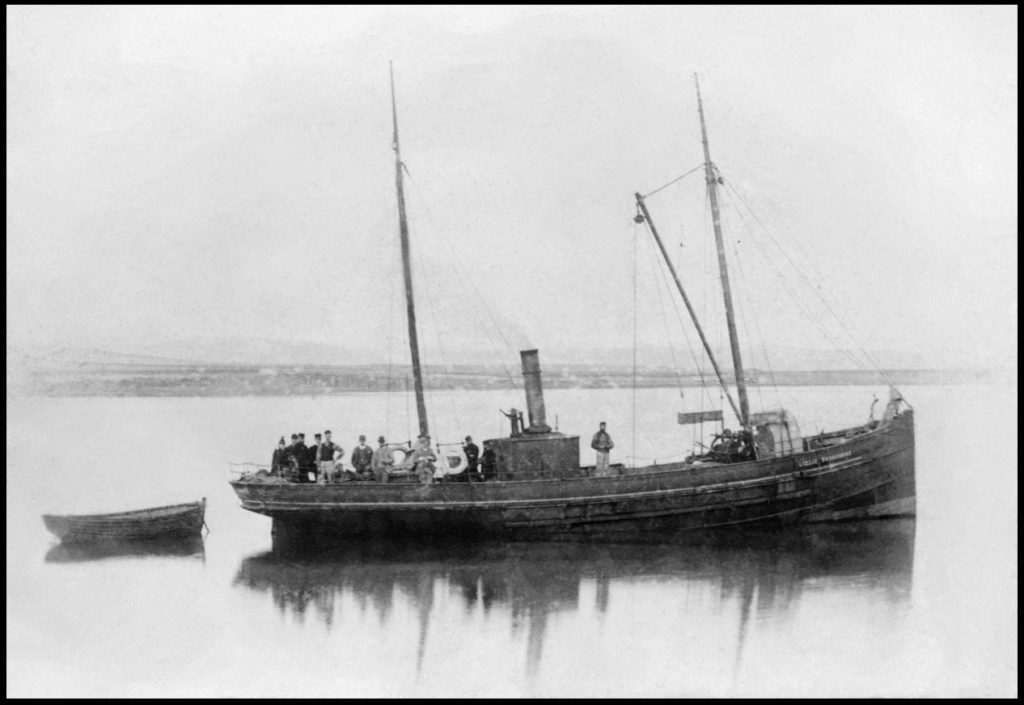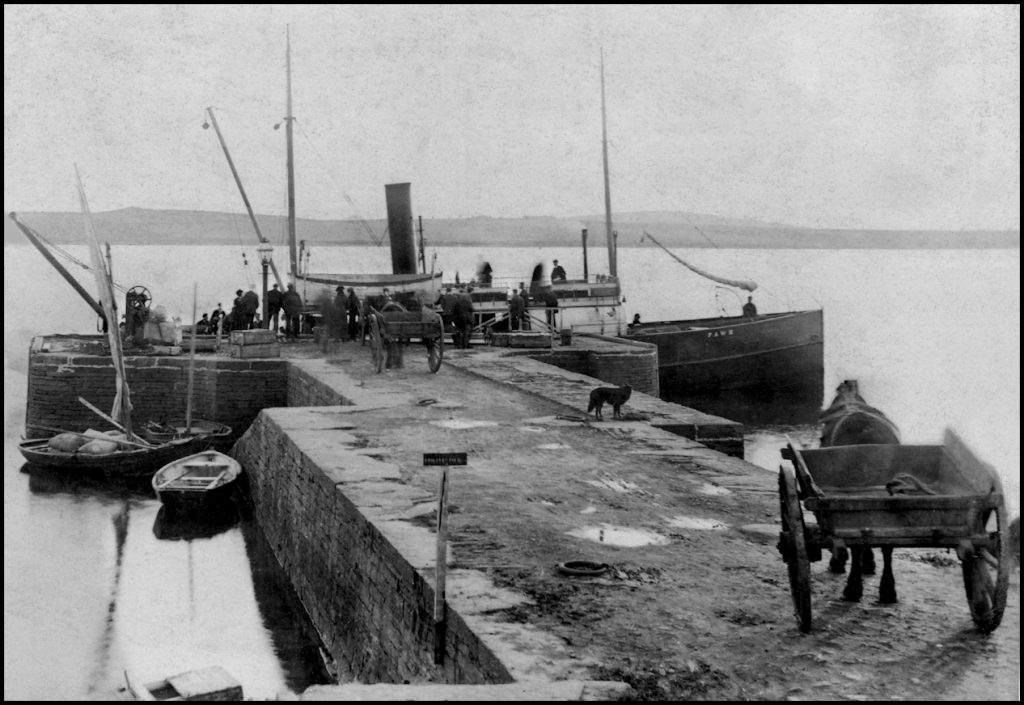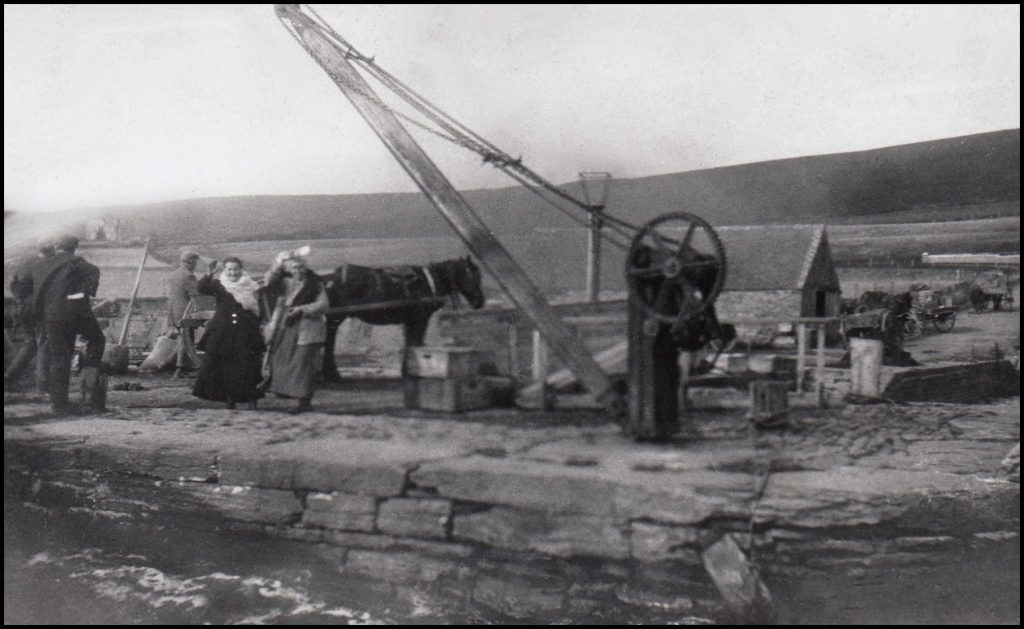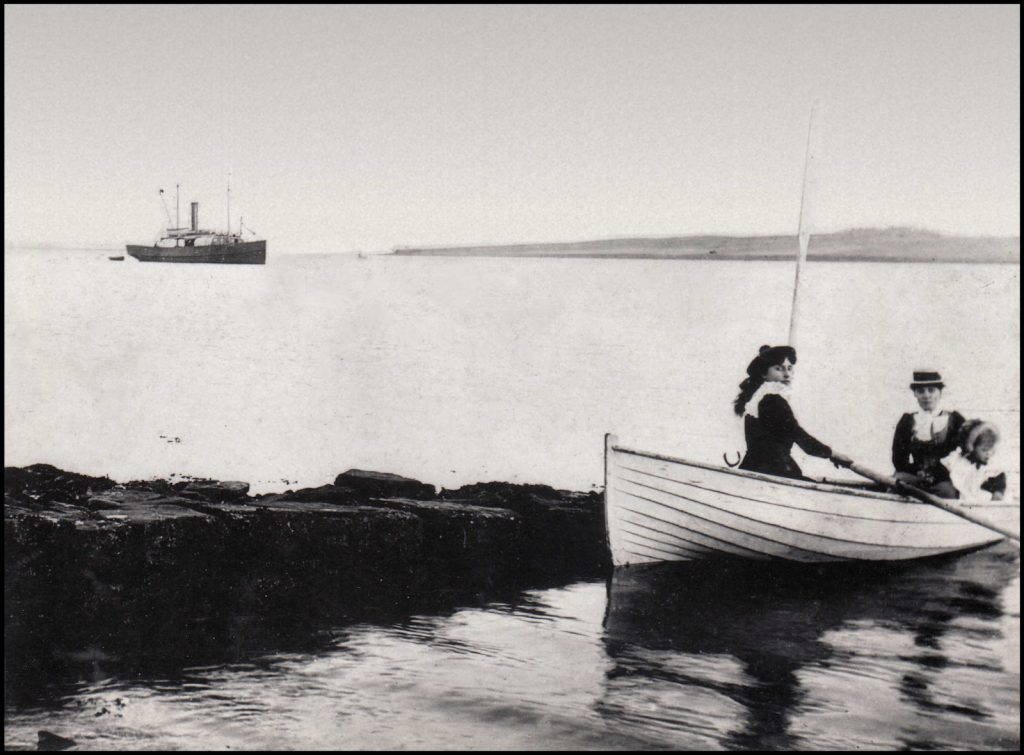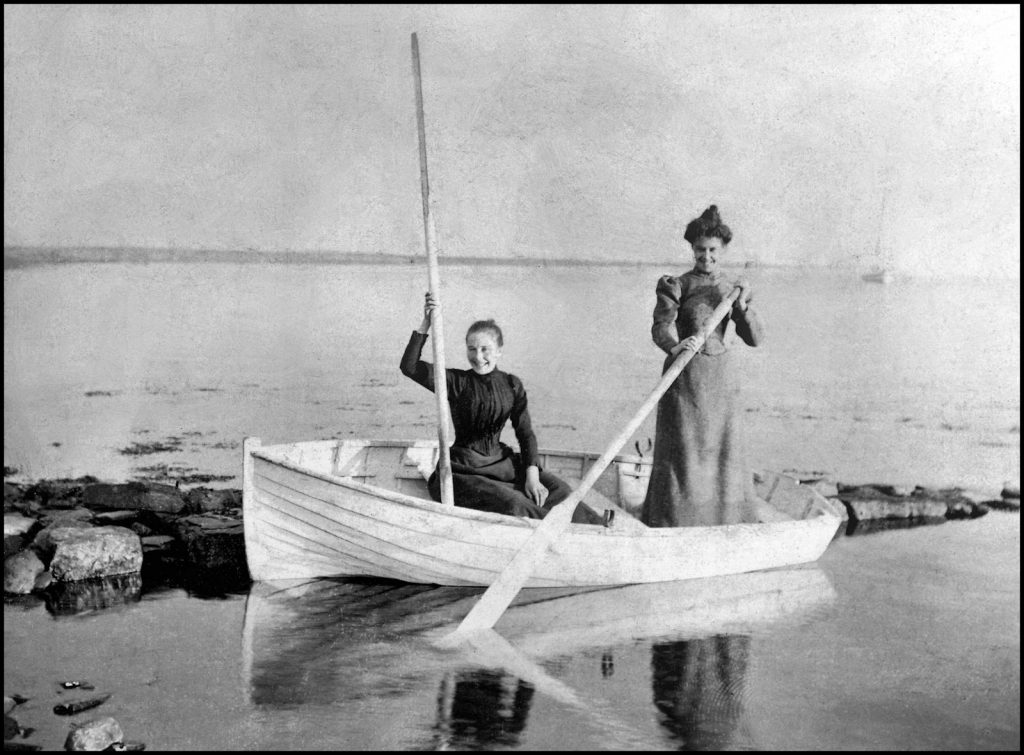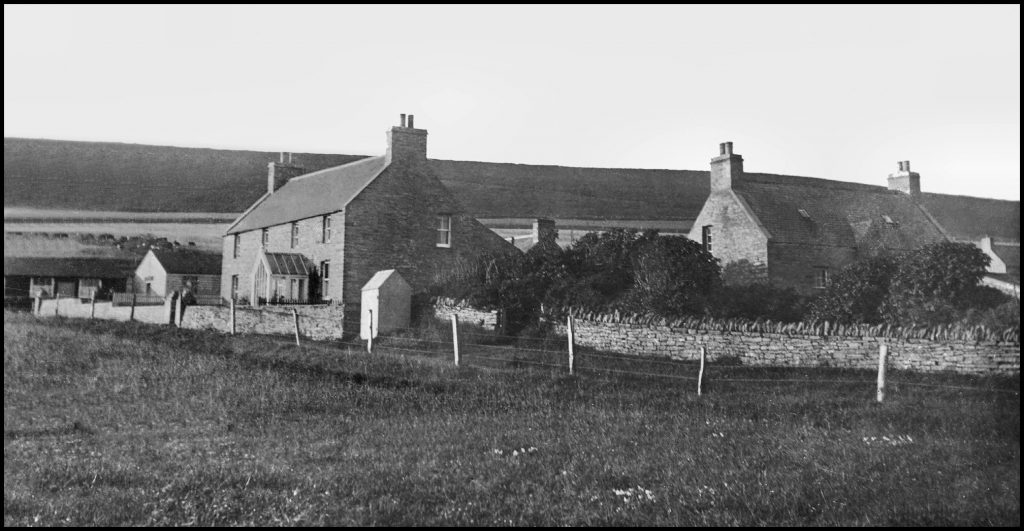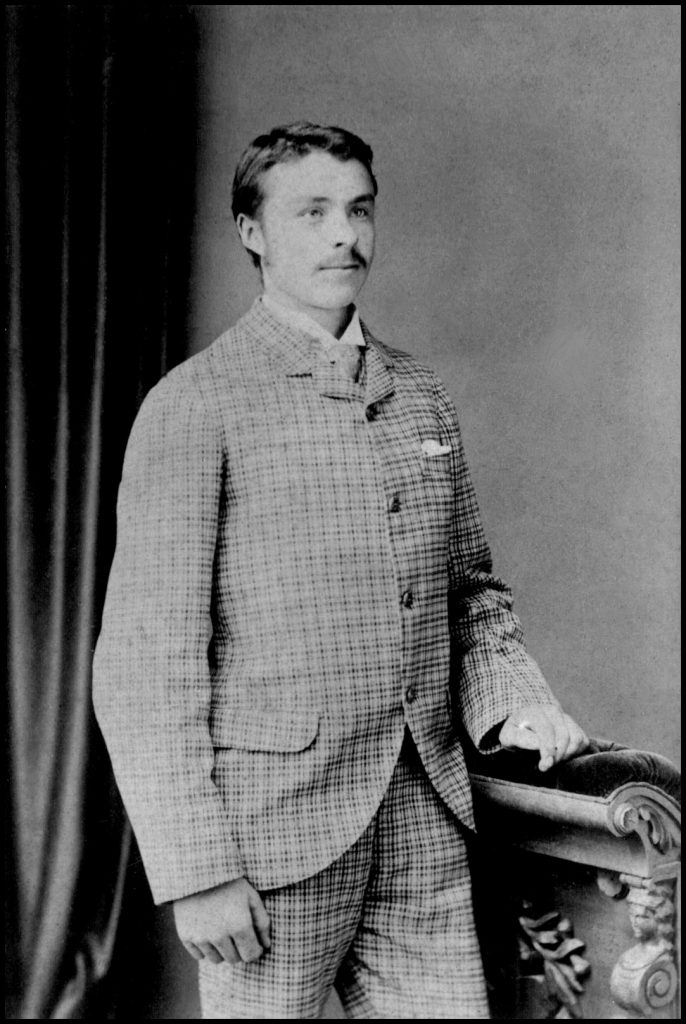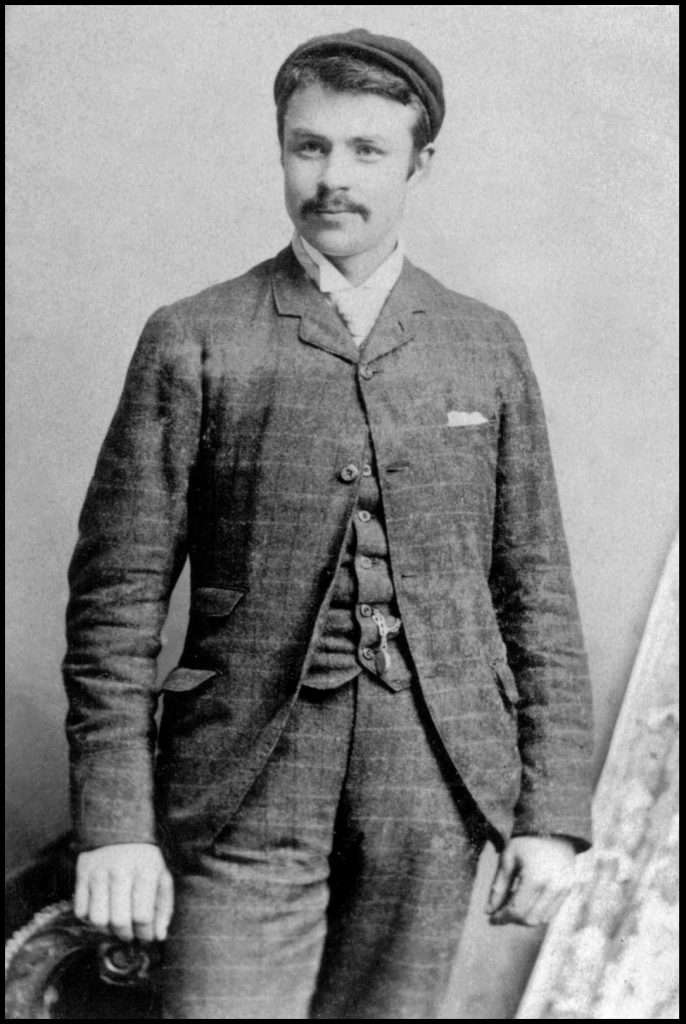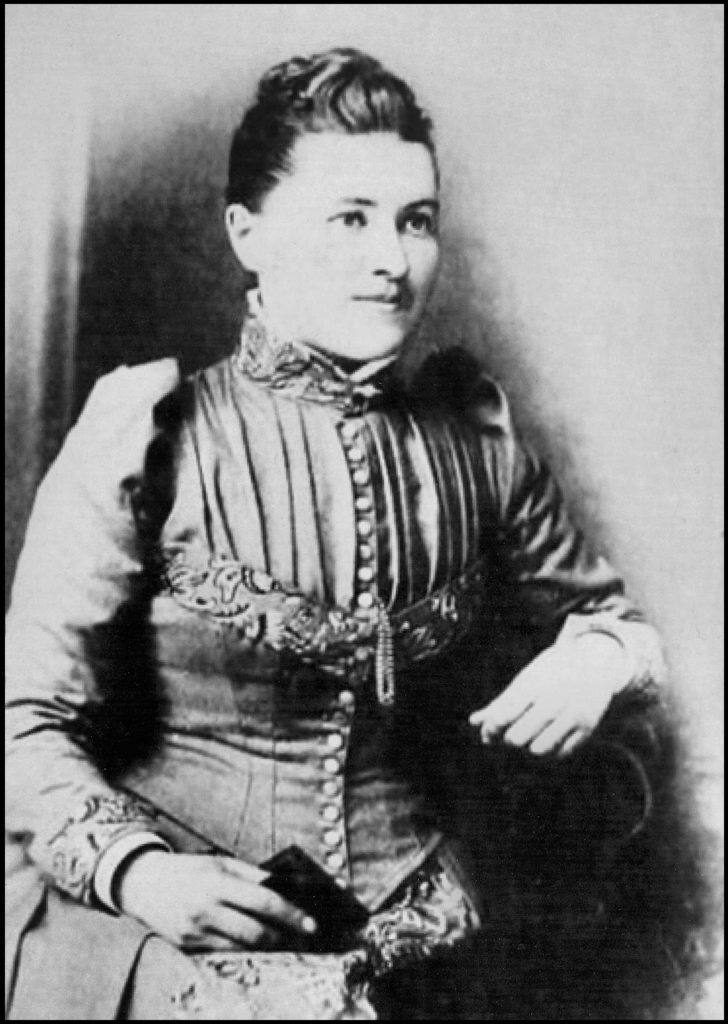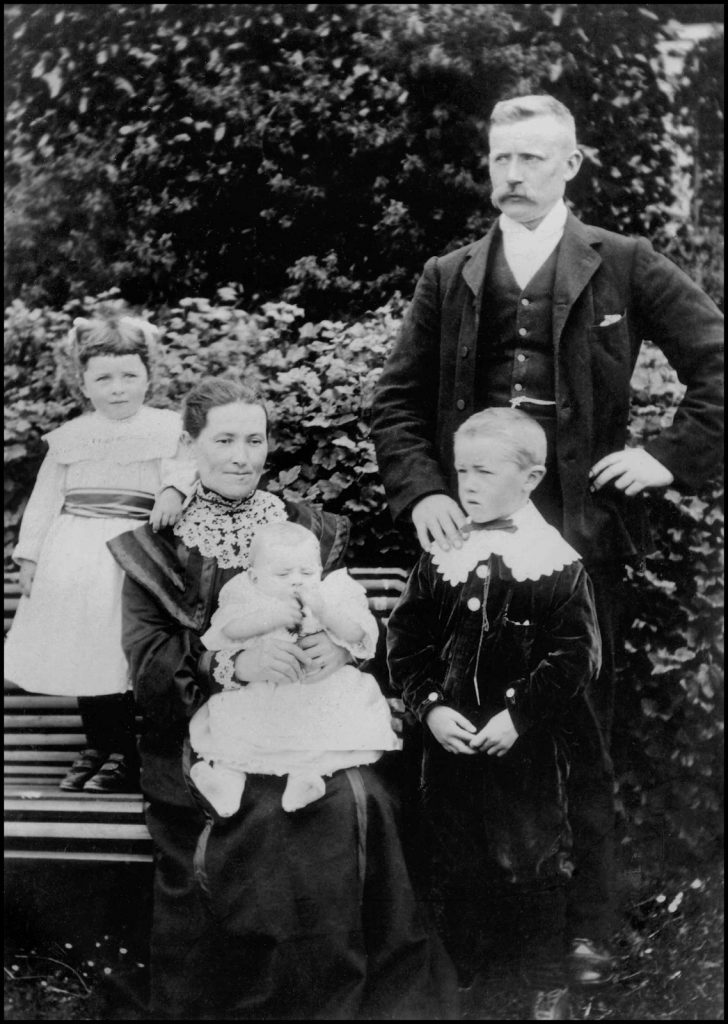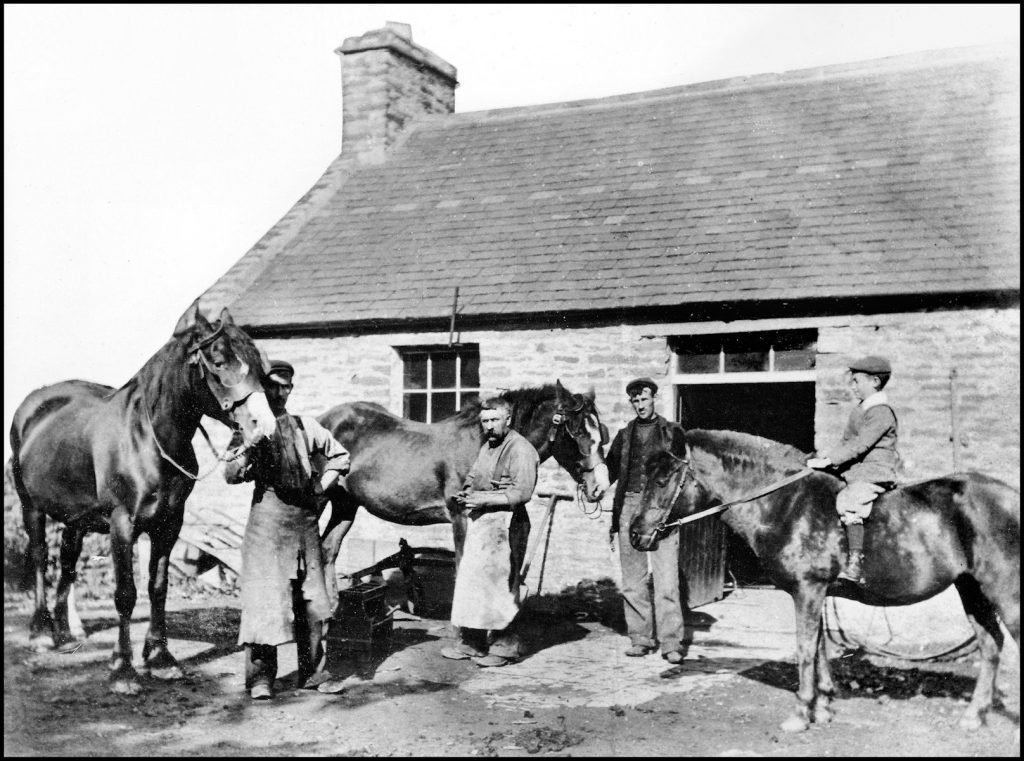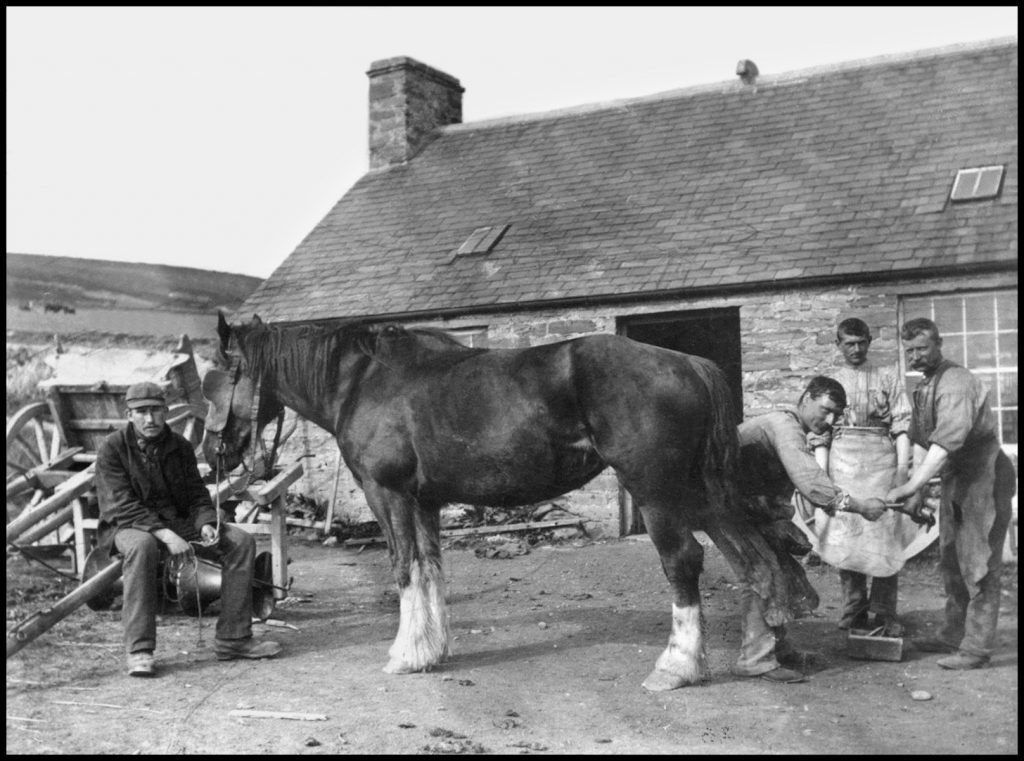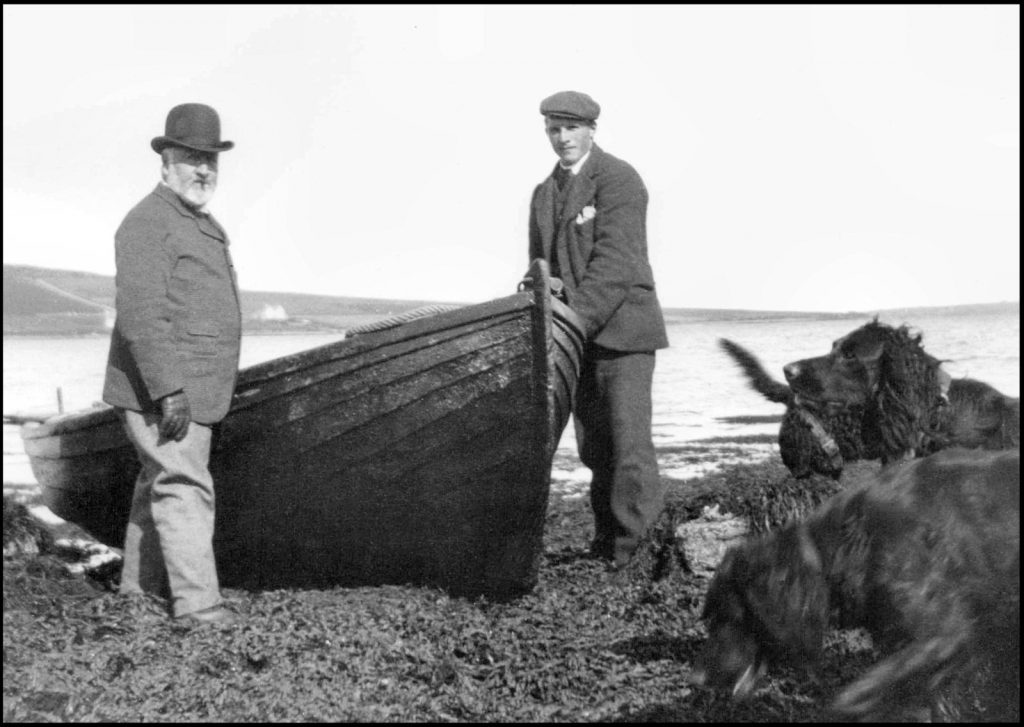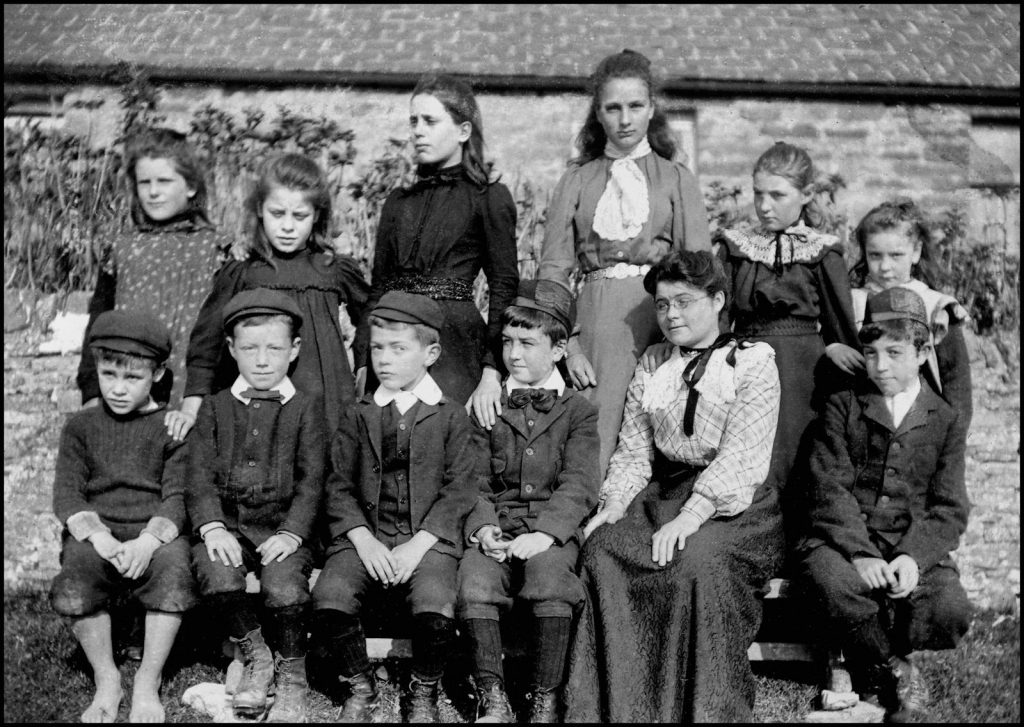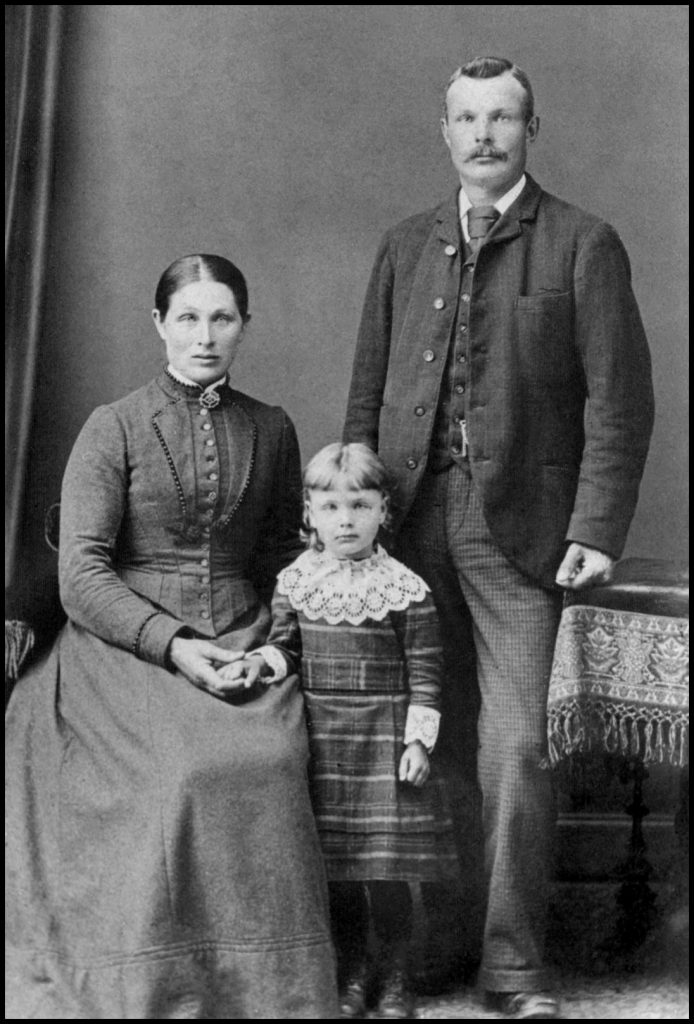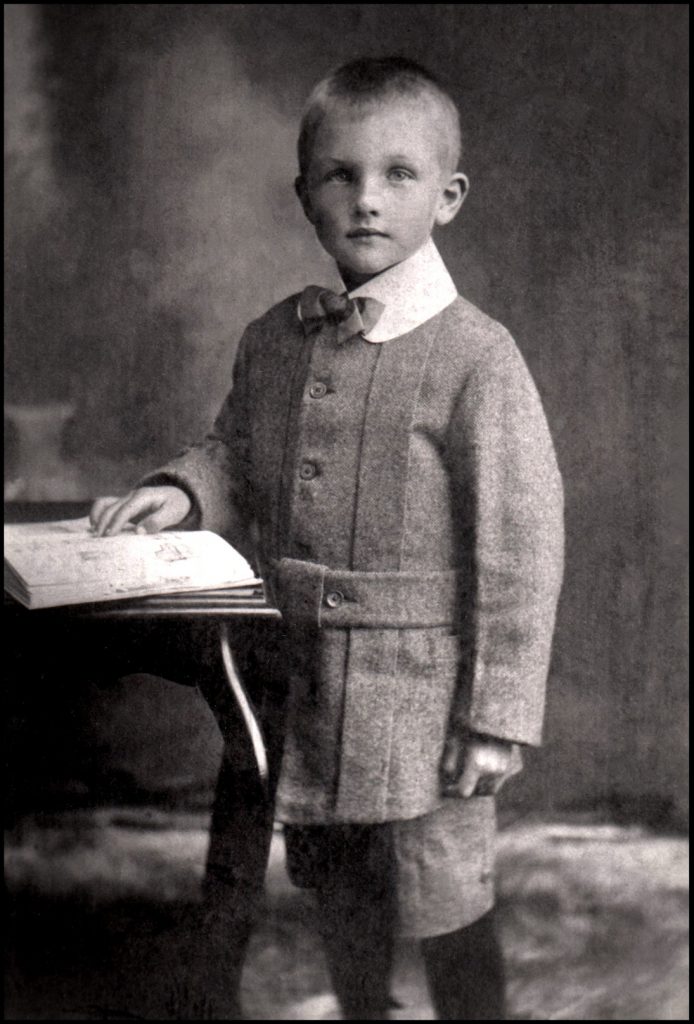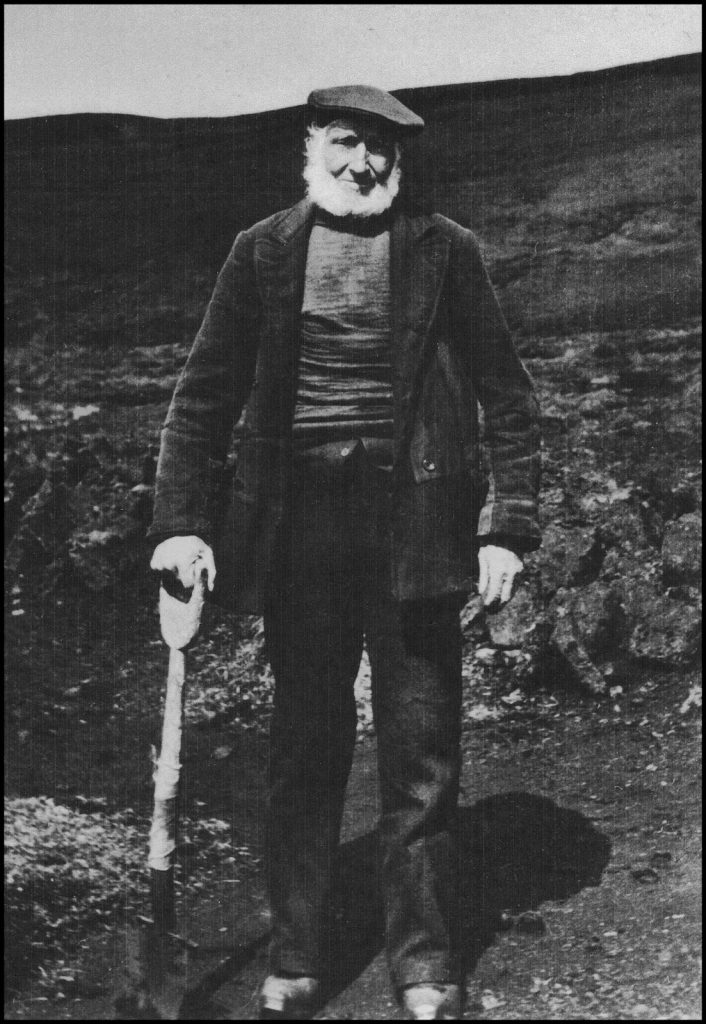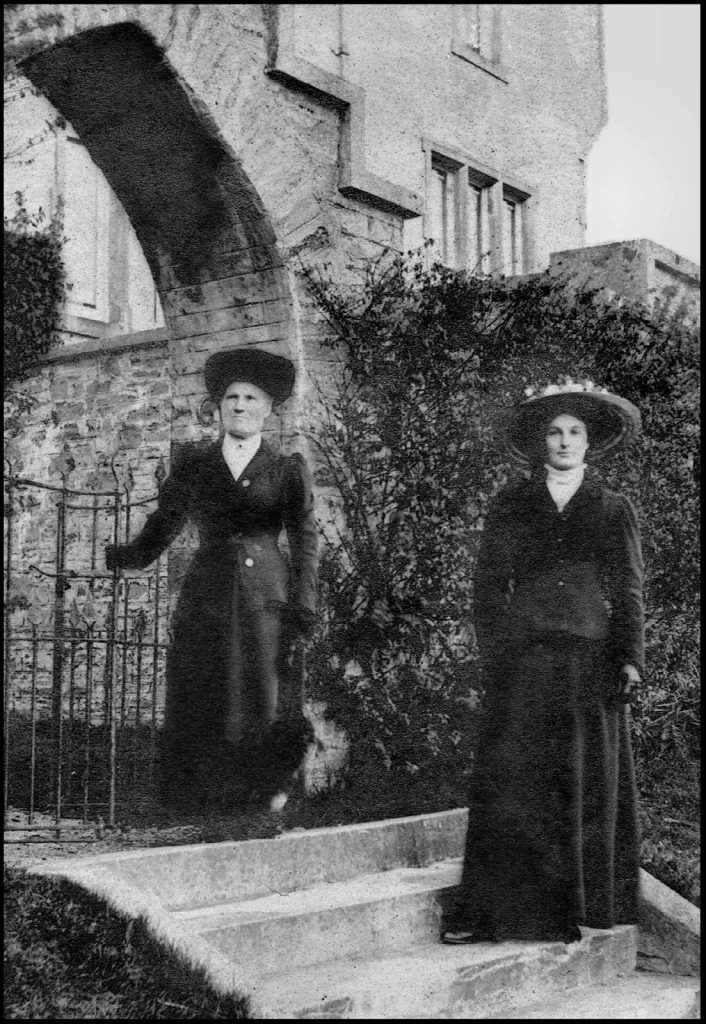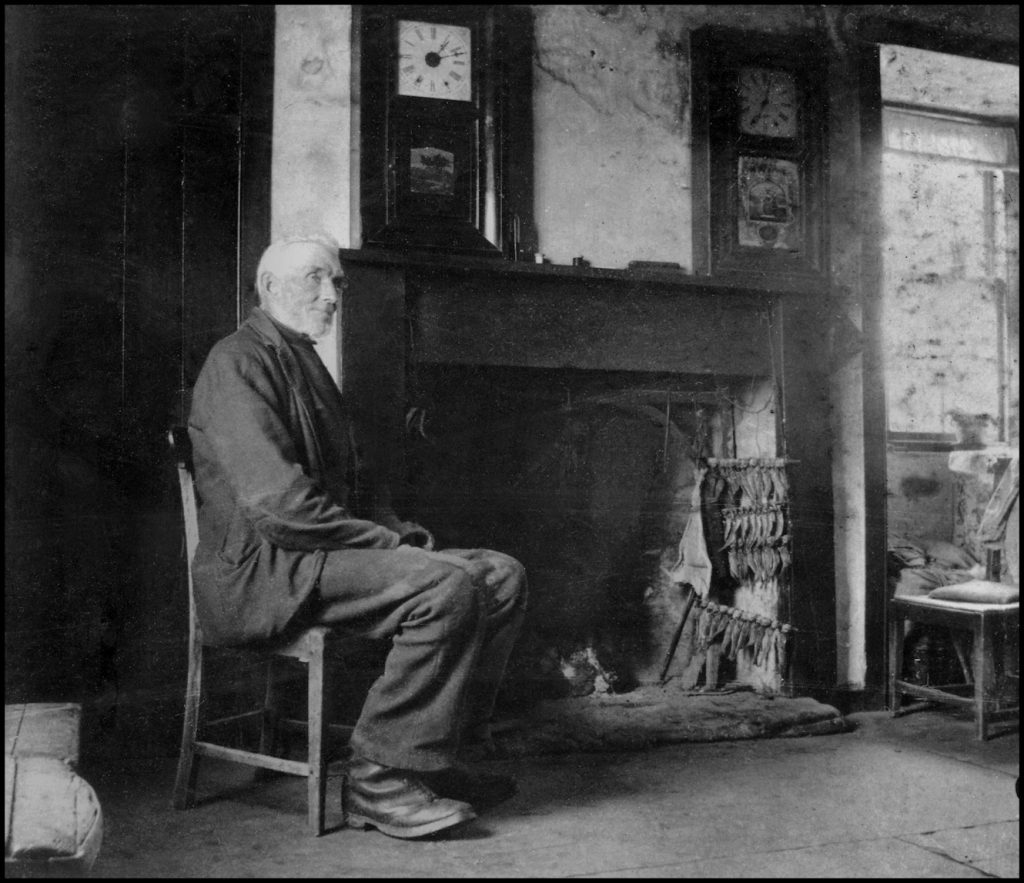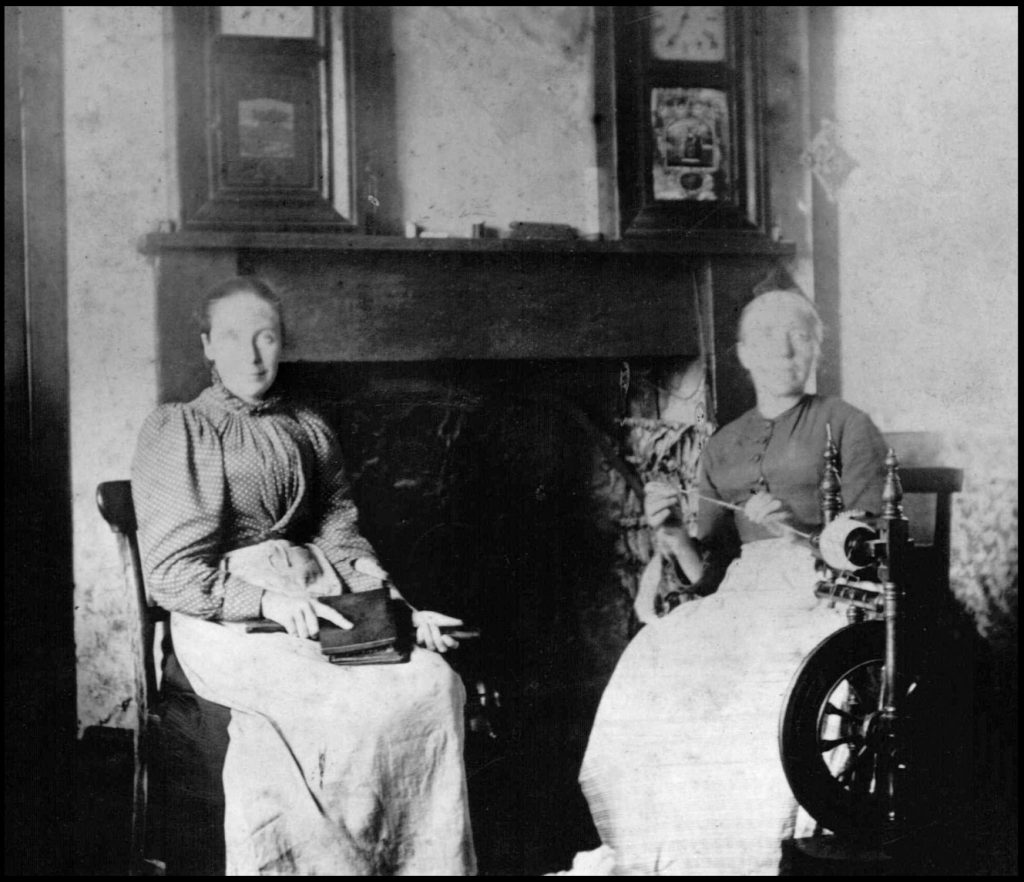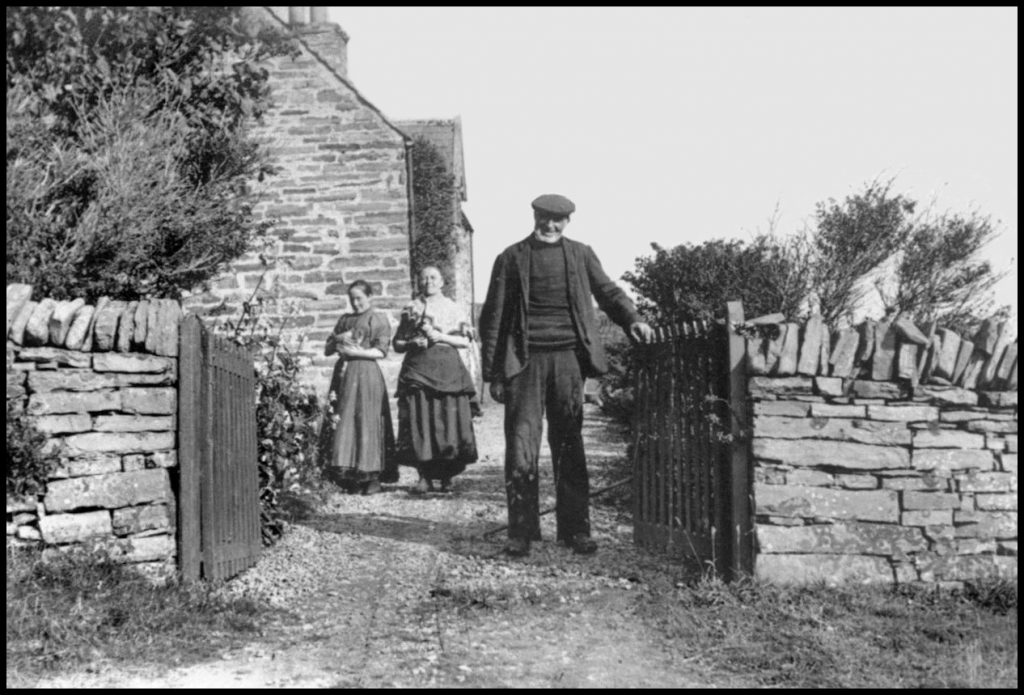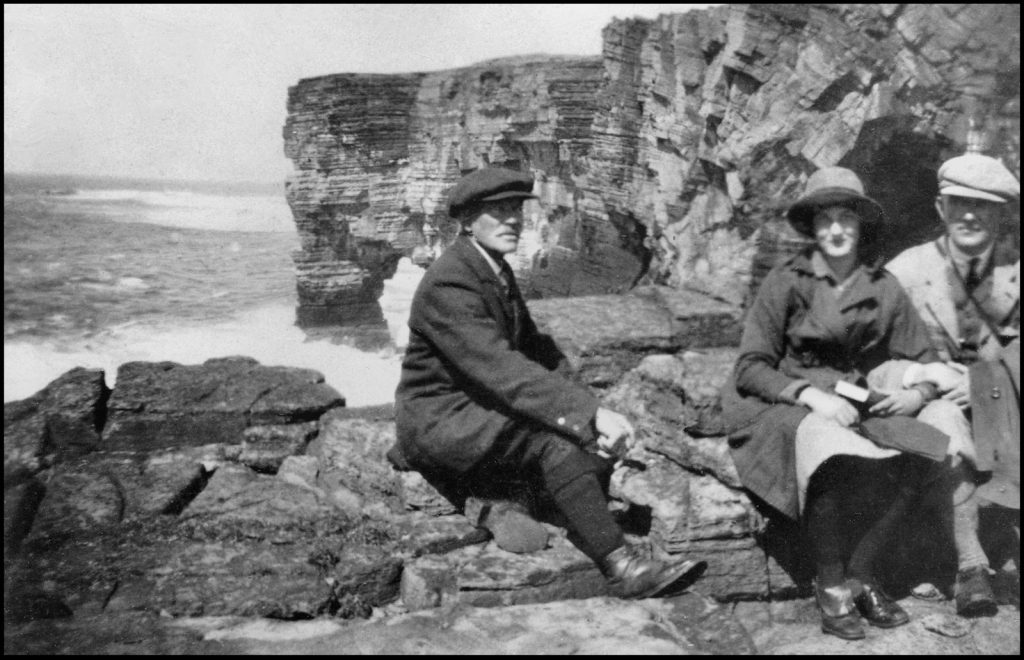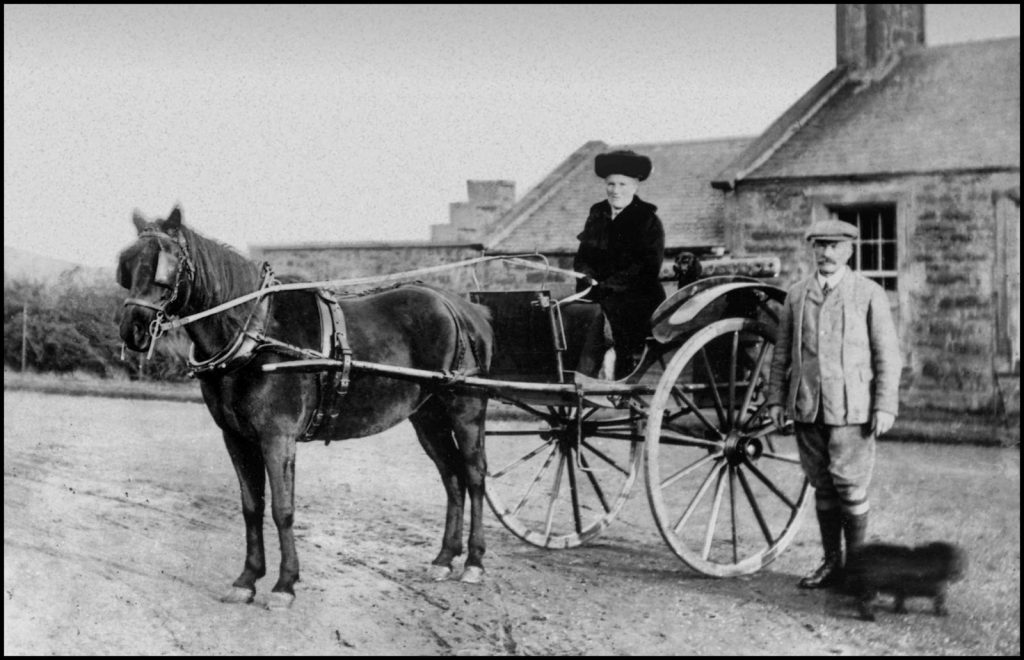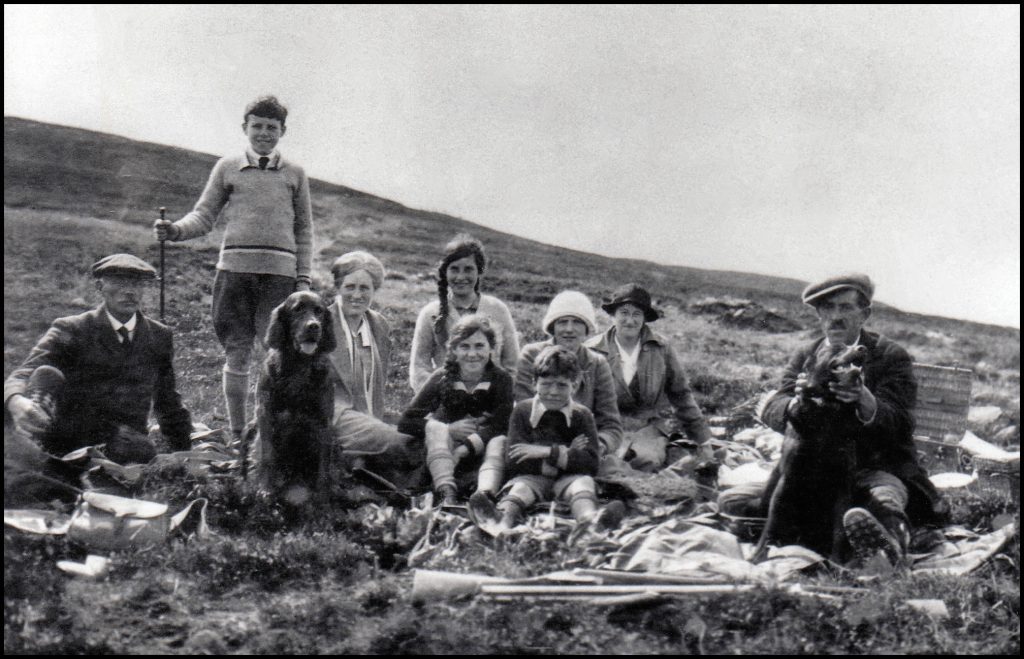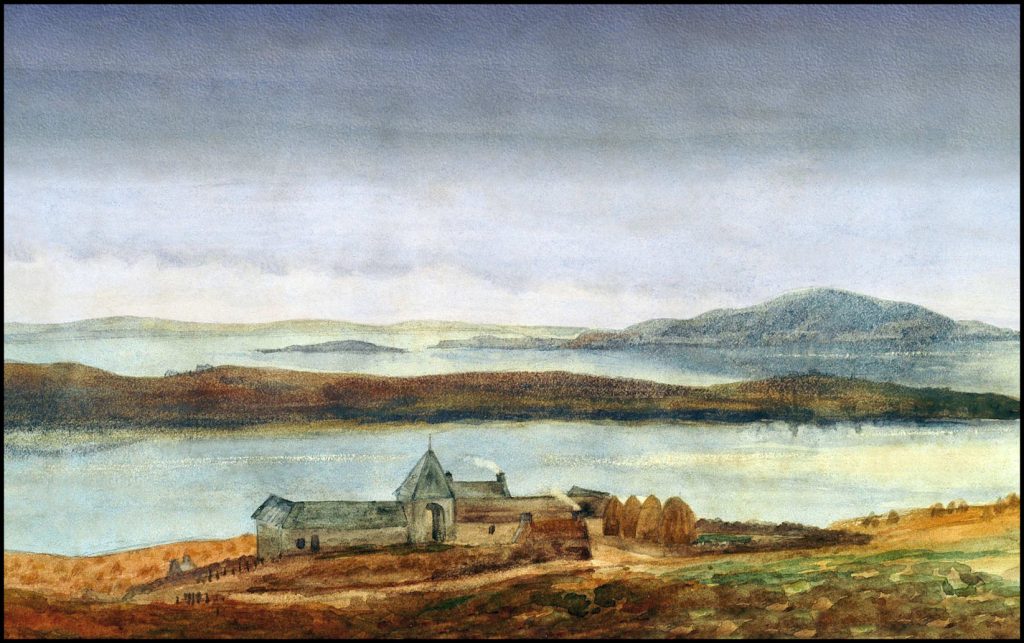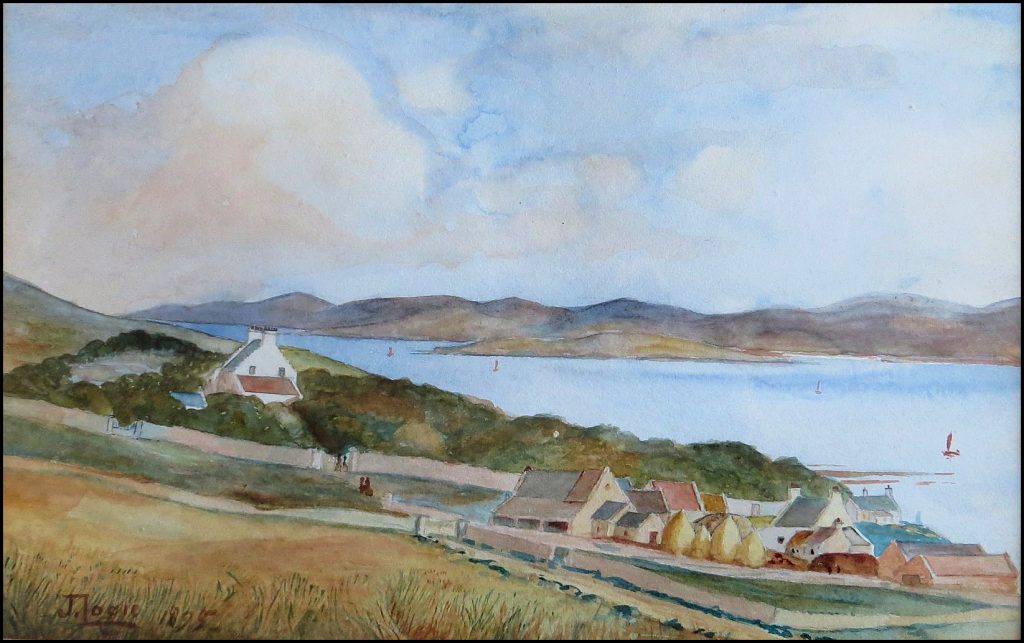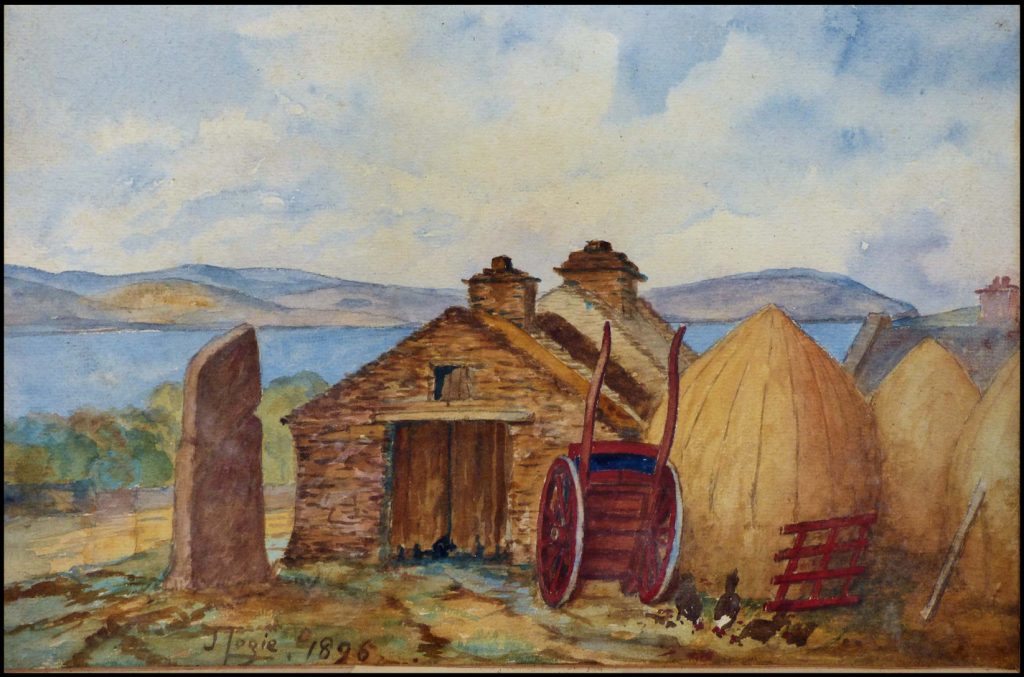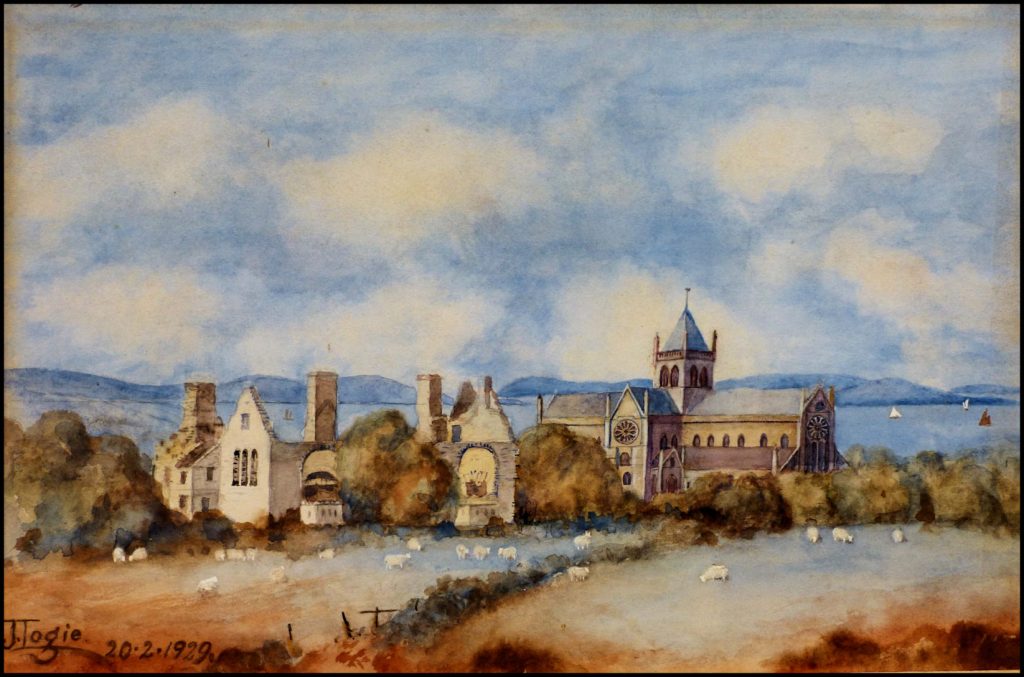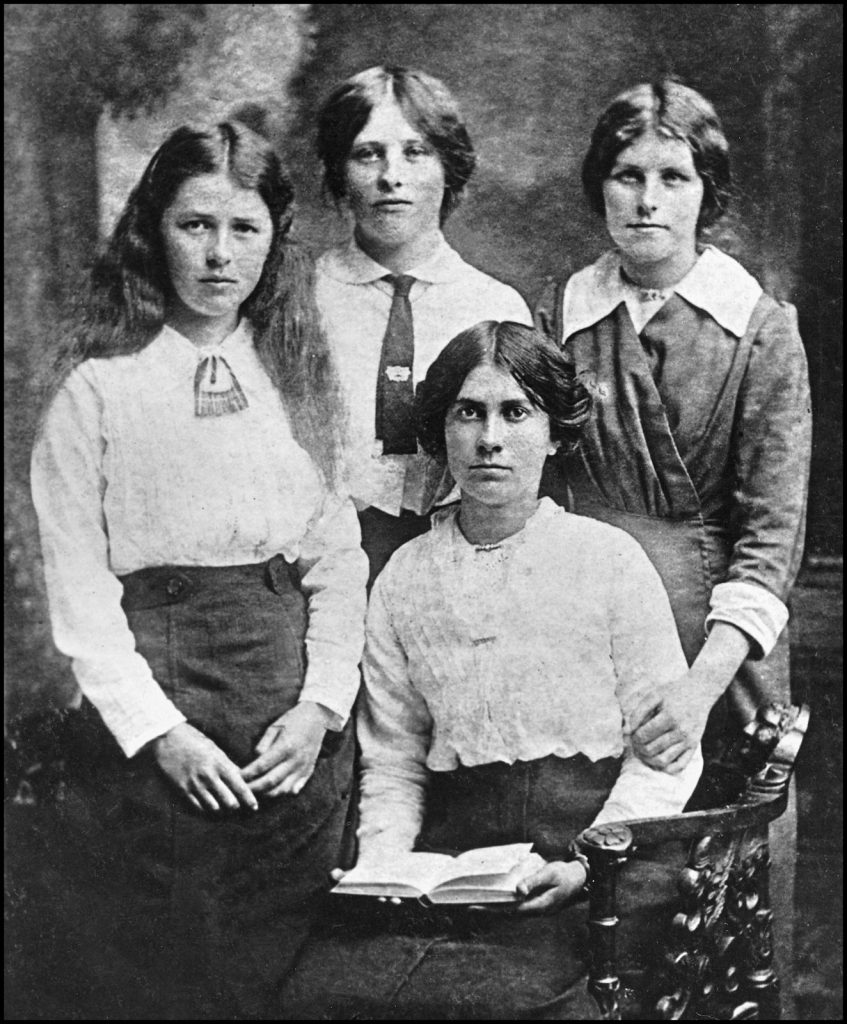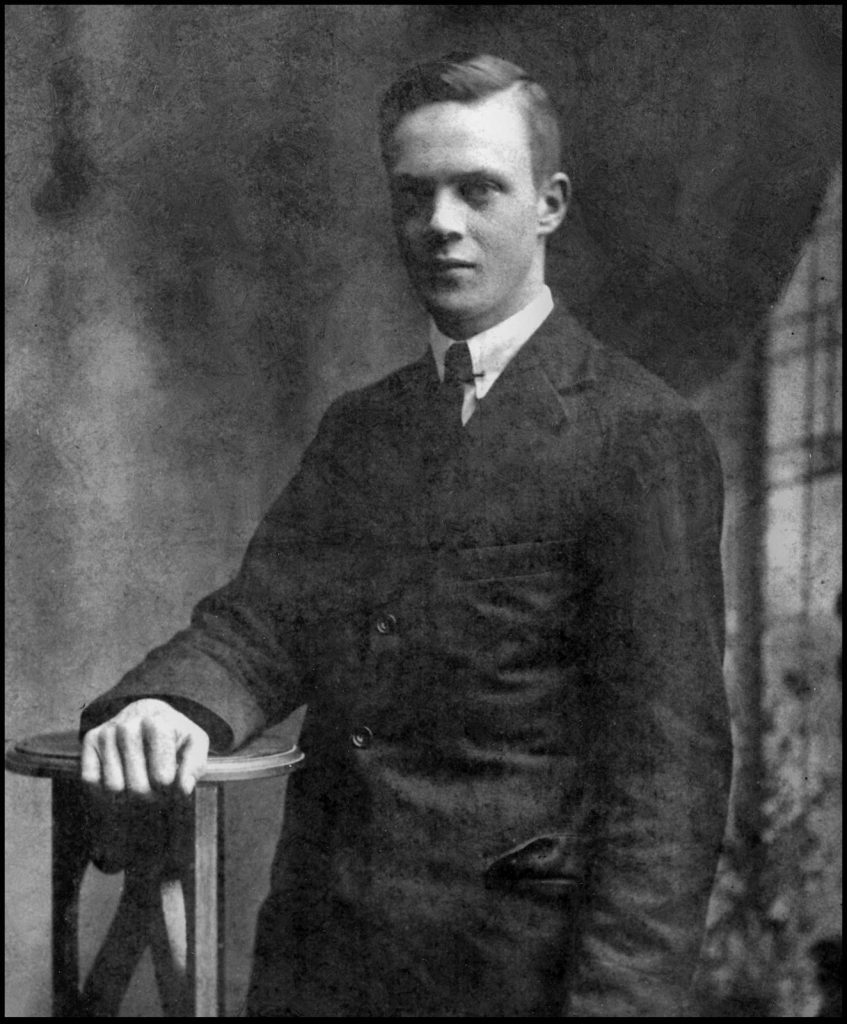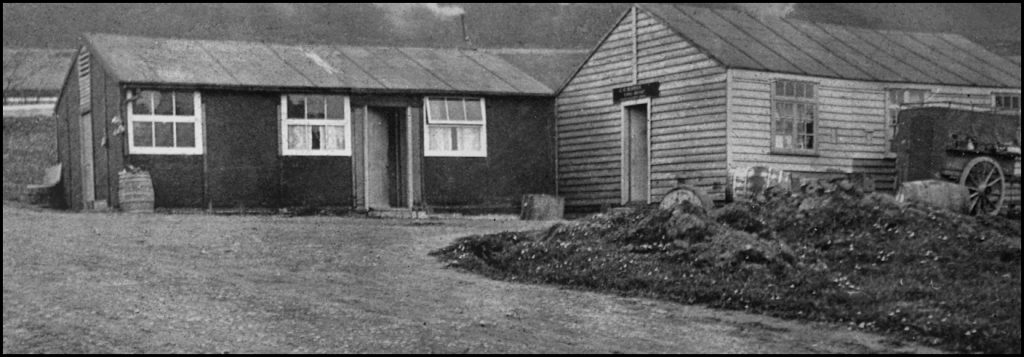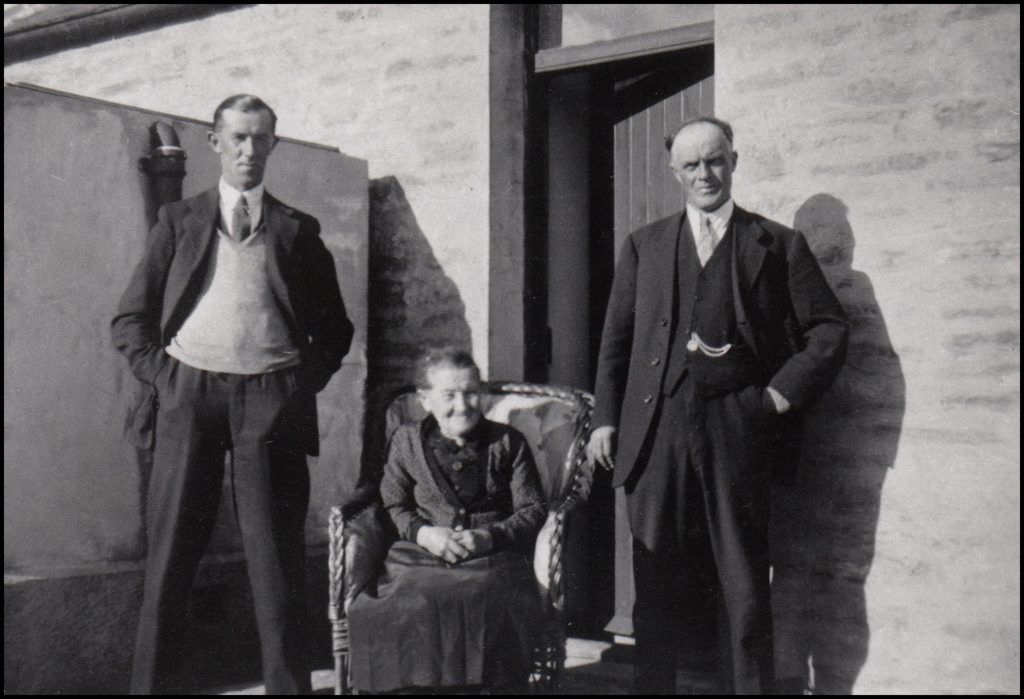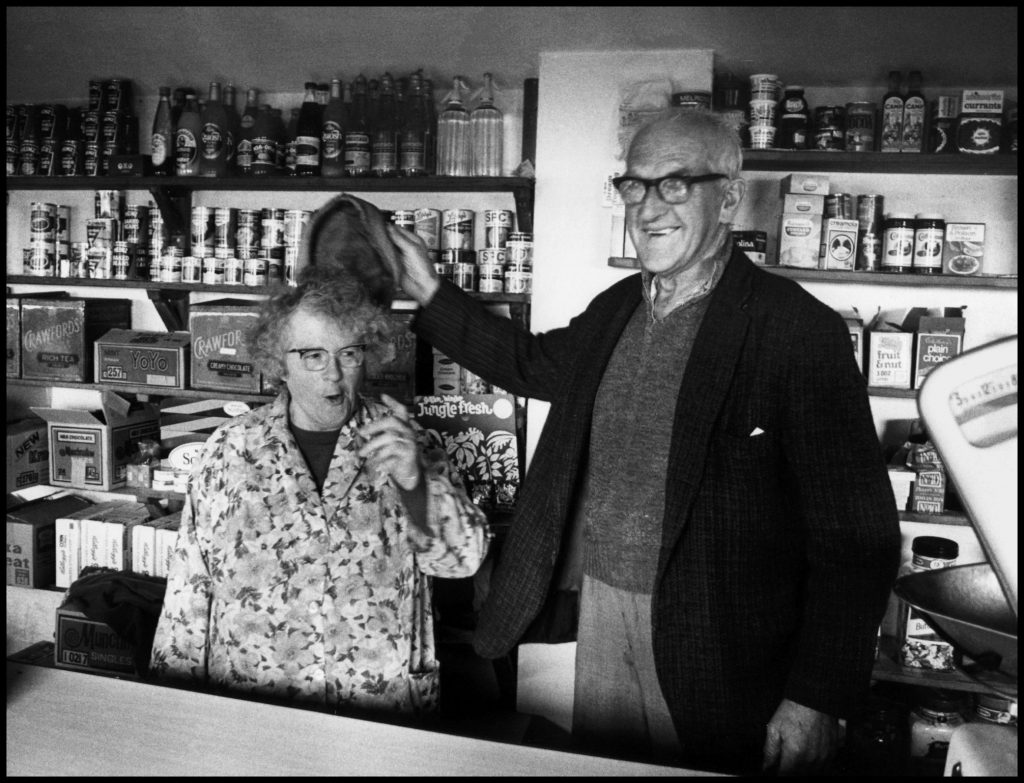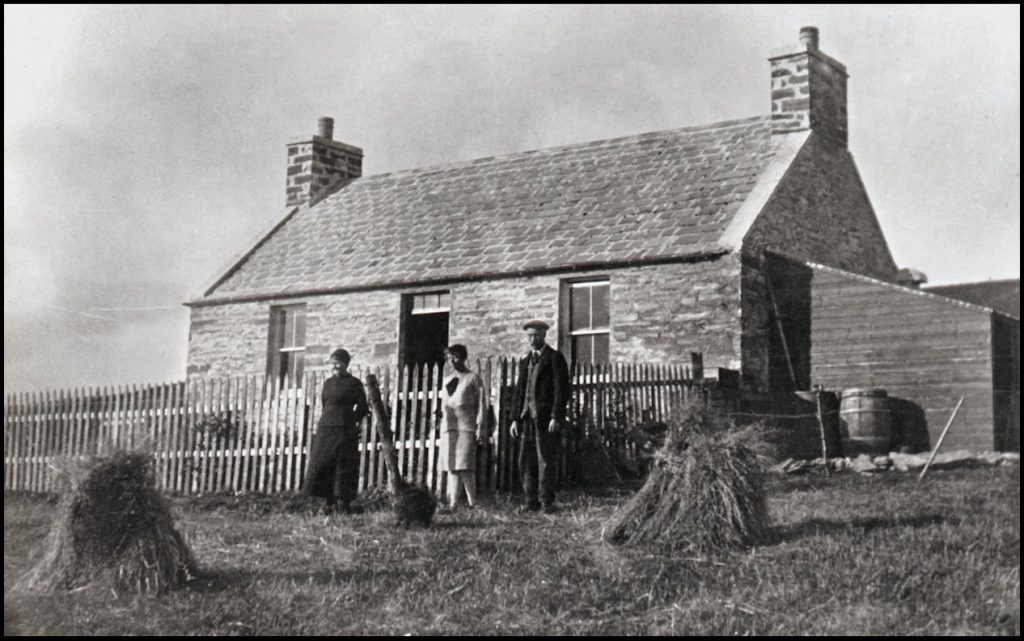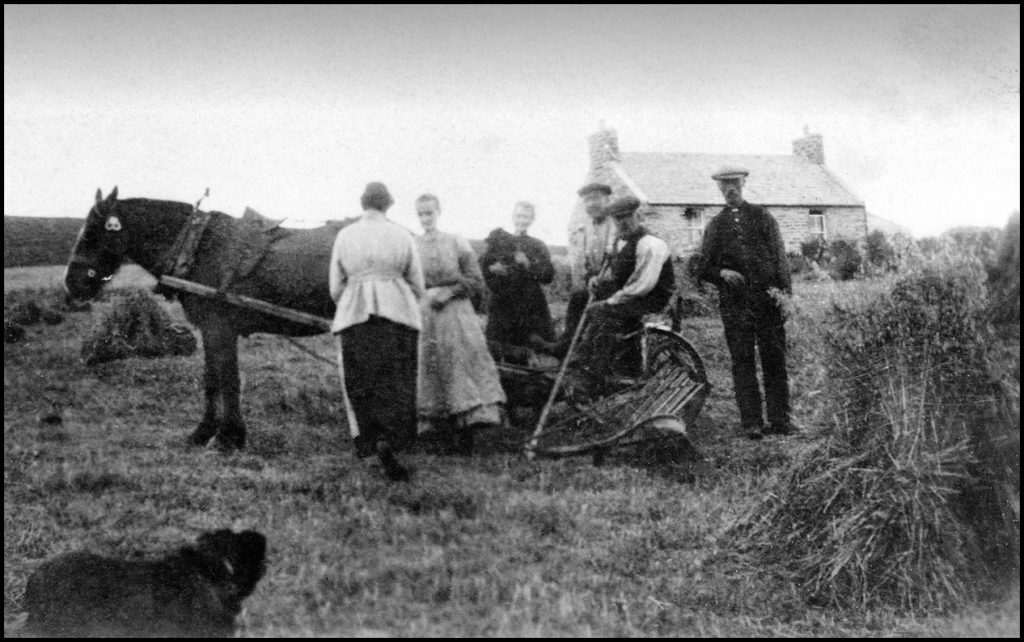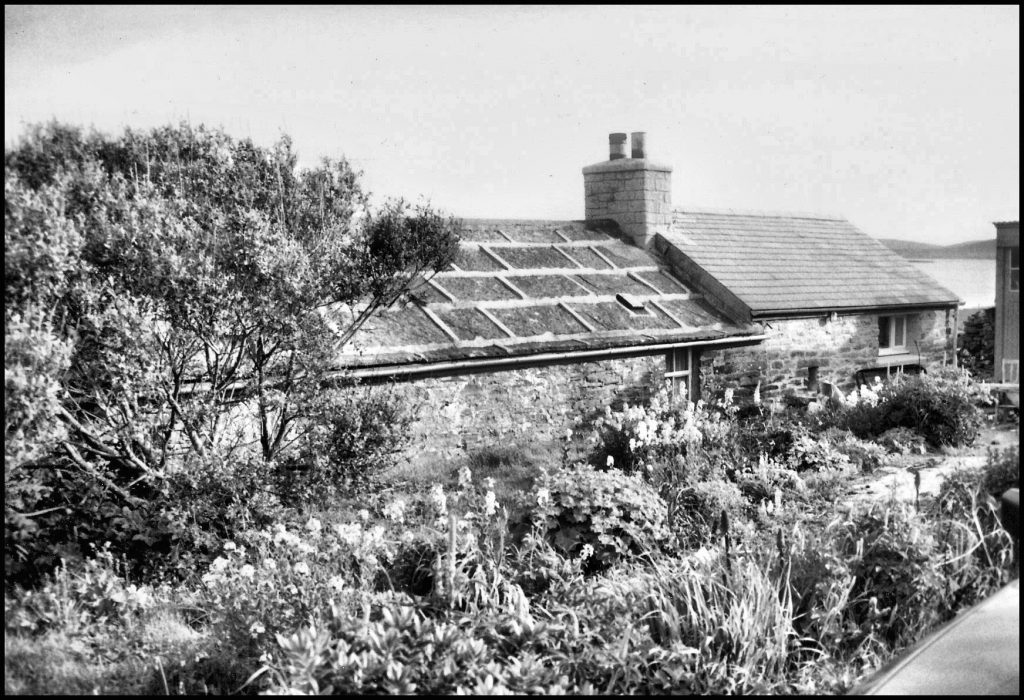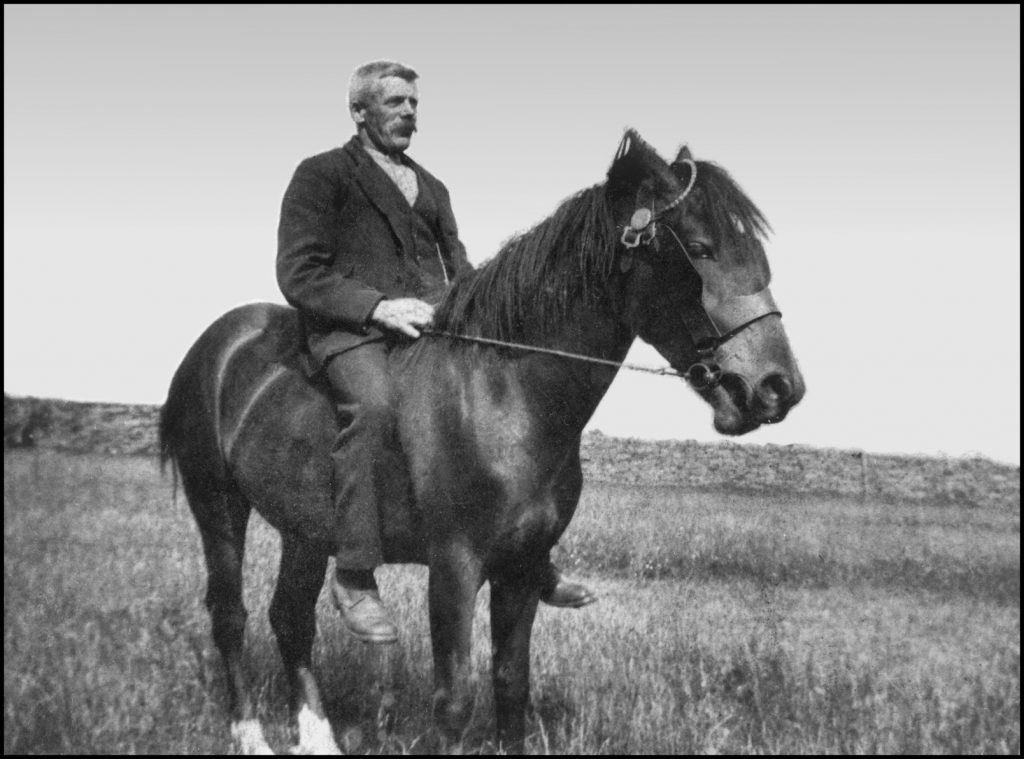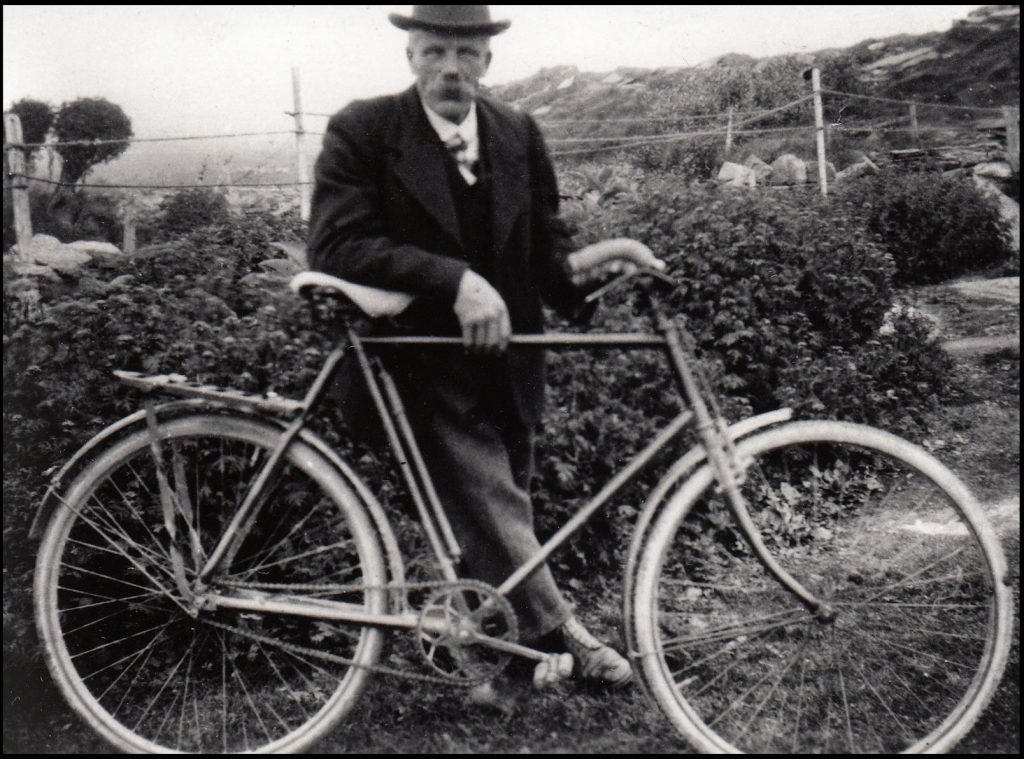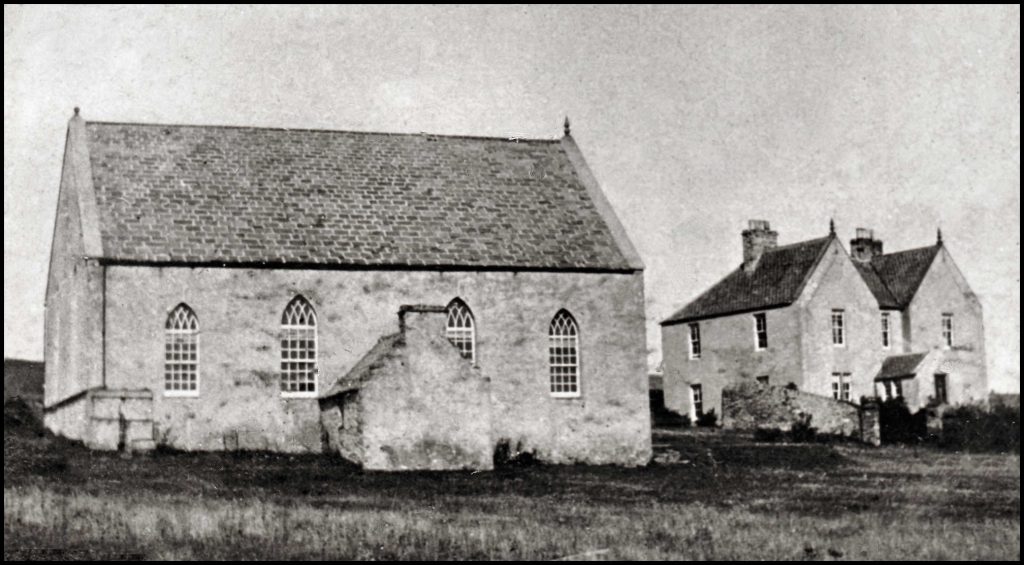The Brinian – including Pier Cottage, Rose Cottage and their Shops,
the Blacksmith and Joiner’s Shops, Ivy Cottage, Viera View,
Daisy Cottage, Cott, Kirkha’, and the U.P. Manse.
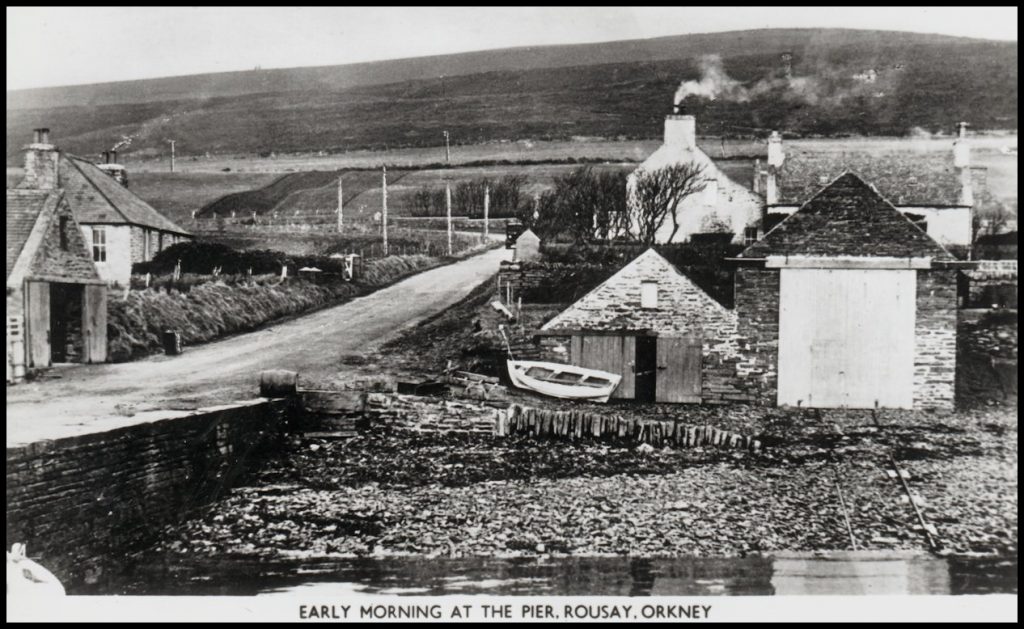
to the left, Pier Cottage above the gable of the shed to the right,
and the reekie lum of Rose Cottage
The Brinian is a small district between the Kirk Brae [known today as the ‘Doctor’s Brae’] in the East and the Burn of Trumland to the West. Though now cultivated for the most part it was not skatted, and does not appear in the old Rentals. [Skats were land taxes paid to the Earls or Bishops of Orkney for land tenancy].
The laird, Frederick William Traill-Burroughs, paid for Trumland pier to be built, and building work was completed in 1871 at a cost of £573, though the surrounding area in those days was fairly sparsely populated. The pier was of course built in that location for his own benefit, being very adjacent to the site for his new mansion house and would facilitate the bringing ashore of all the necessary building materials by ship from Kirkwall. Another of Burroughs’ ventures was the founding of the Rousay, Evie and Rendall Steam Navigation Company. The company’s small steamer was the ‘Lizzie Burroughs’, a 61-foot long 31-gross-tonnage vessel with a 15hp engine. She was a familiar sight plying the waters between Rousay and Kirkwall. Her schedule was as follows: Sourin 7.30am; Egilsay 7.45; Trumland 8.00; Wyre 8.15; Hullion 8.45; Evie 9am; Tingwall 9.40; Gairsay 10.00; Rendall Point 10.20 – and then on to Kirkwall.
The company lasted just 13 years and folded due to financial problems, the steamer’s mechanical defects, and even shipwreck. She was out of action for six weeks in 1883 for repairs, and suffered further damage the following year when she broke loose from her moorings and was driven ashore on Egilsay. She was badly holed and had to be towed to Stromness for repairs. In 1892 the company ceased trading and the Lizzie Burroughs was sold to Robert Garden for £484. The Orkney Steam Navigation Company’s vessel Fawn then provided the lifeline service between the isles and Kirkwall.
The reverse of the above photos reveals these are young ladies from Trumland House,
at the Leading [or landing] stone, just east of the pier.
Living in two buildings near the new pier in 1871 were the Marwick and Yorston families. Mary Marwick was a 52-year-old widow, and living with her was her 16-year-old daughter Jessie Alexina, who earned a living as a dressmaker. Mary was the daughter of Hugh Craigie and Mary Yorston of Knappknowes, Westside, and she was born on April 26th 1819. In 1846 she married William Marwick, son of Hugh Marwick and Mary Yorston of Clook, Frotoft, who was born on January 31st 1818. They had three children; William, Peter and Jessie Alexina. William died in 1855 at the age of 37.
Archibald Yorston was a 42-year-old fisherman, living in the Brinian with his wife Ann (44) and children David (14) and Jemima, a 13-year-old scholar. Ann’s widowed mother also lived with them, then in her 81st year. Archibald was the son of John Yorston and Mary Barnet, who lived in Whistlebare, Egilsay. In 1854 he married Ann Leask, who lived with her widowed mother Ann in Hillhouse, Wyre.
In the 1881 census these two dwellings were identified as Brinian Cottage West and Brinian Cottage East – latterly known as Ivy Cottage and Viera View.
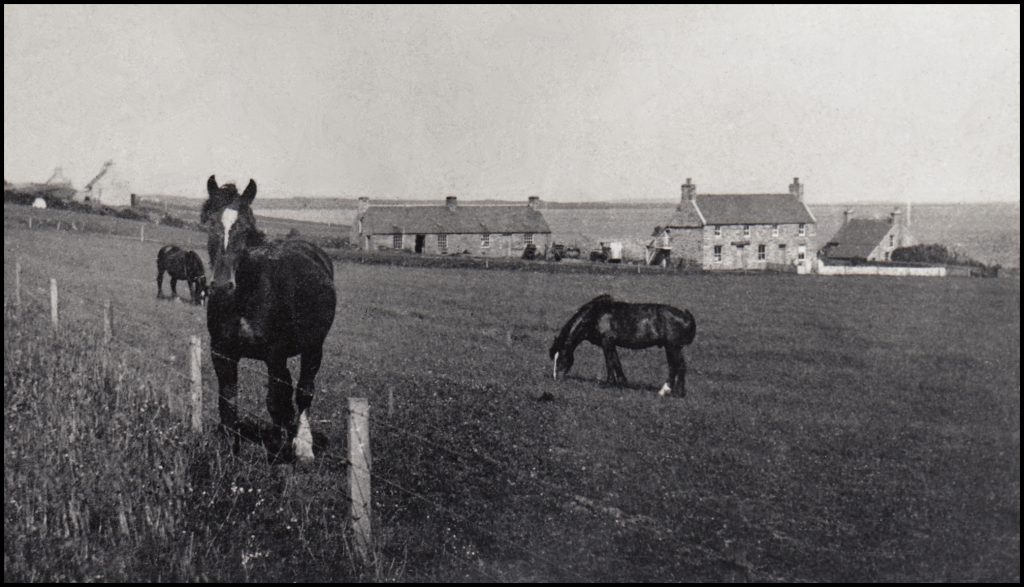
Harrold’s Shop and Rose Cottage, and Pier Cottage to the right – c1920
The West cottage was then occupied by agricultural labourer James Low and his wife Mary. James was the son of James Low and Christina Hourston of Quoyjennie, just above Hunclet in Frotoft, and he was born in 1848. In 1880 he married Mary Craigie, the daughter of Gilbert Craigie and Jean Gibson of Turbitail, who was born on August 2nd 1848. They had two children, Mary Jean and James, who later became a gardener at Westness House.
Mary Marwick lived in the East cottage, but now with her son Peter, a 29-year-old farm servant. At that time they had a lodger, 35-year-old John Fraser, who was employed as a road maker foreman.
The census of 1881 contained the first mention of Pier Cottage, built in 1877 especially to house the laird’s yachtmaster John Logie, having the privilege of living there rent-free. He was born at Geo, Westness, in January 1826, the son of John Logie and Mary Craigie of Whome. John married Cecilia Gibson, Vacquoy, and they raised a family of ten children: Mary, who was born in 1855; John, born in 1856; Alexander, in 1858, but died just four years later; William, in 1861; a second Alexander, born in 1863, but he too died at a young age; Annabella, in 1865; Henrietta Williamina [Minna], who was born in 1867, Charles Burroughs, in 1869, Hugh, born in 1872, but dying just eight years later; and James, who was born in 1874 – his mother Cecilia dying at the same time. Her widower husband John married a second time – to Jane Harcus, Blowhigh, daughter of John Harcus and Jean Reid, who was born in 1843. They had three children: twins Alexander and Mary, born in 1878; and Lizzie, who was born in 1883.
Come the census of 1891 the occupants of Brinian No. 1 were David Craigie and his family, paying an annual rent of £4. David earned his living as a joiner. He was the son of Gilbert Craigie and Jean Gibson of Turbitail, born on March 14th 1857. He was the younger brother of Mary Low living at the West cottage. On September 7th 1882 he married 21-year-old Ann Gibson, daughter of John Gibson and Jane Mainland of Knarston. They had four children between 1883 and 1895, Ann dying six days after the birth of their youngest child.
No. 2 was occupied by Isaac Marwick who was a blacksmith in the Brinian. Born on October 28th 1857, he was the son of Robert Marwick and Bell Mainland of Essaquoy. On December 13th 1883, he married Sarah Harrold, daughter of John Harrold and Margaret Mackay of Rendall, and they had two children; Maggie Ann, born on October 2nd 1884, and Robert, born on October 7th 1886.
Isaac served as engineer on the packet Lizzie Burroughs that plied between Rousay and Kirkwall in the 1880s and ‘90s. After that he became engineer on S.S. Hoy Head sailing between Stromness and the south isles. Later he was engineer on the S.S. Southford sailing out of Leith. While leaving Harwich harbour in 1917, the ship hit a mine and sank. All the crew were rescued but Isaac suffered a heart attack and died as a result of sudden immersion in cold water after the heat of the engine room. He was 59 years old when he died.
Two photos, taken ten years apart, of an immaculately-dressed Charles Burroughs Logie,
1890 to the left and the image on the right taken in 1900.
In 1893 John Kirkness occupied No. 1, paying rent of £3 10s 0d. He was employed as an engineer on board General Burroughs’ steam yacht Curlew. A year later John had moved on and a new family were in residence in what was now called Ivy Cottage. Head of the household was Charles Burroughs Logie, a joiner by trade, his family and birthdate of 1869 mentioned previously. His workshop and the Trumland smiddy were under one roof, just up from the pier. In 1896 Charles married Alice Gibson, daughter of David Gibson, Hullion, and Ann Sinclair, Newhouse, who was born in 1871. Charles and Alice had four children: Charles Sinclair, known as Lalla, born in 1903; Harry, born in 1904; Alice, known affectionately as Girlie, was born in 1906; and David John, born in 1908, and he was known as Totto.
At the time of the 1901 census the Logie’s neighbours along at Brinian No. 2, or Viera View as it is more commonly known, was blacksmith William Sutherland and his family. William was from Flotta, and was born in 1869. In 1899 he married Margaret Harrold, the then 37-year-old daughter of Hugh Harrold, Rendall, and Margaret Mainland, Bu, Wyre. They had three children: George, born in 1900; Maggie Simpson [Peggy] born in 1901, who later married George William Marwick [who latterly had a shop at the pier]; and Hugh Harrold, who was born in 1904 and later emigrated to Canada.
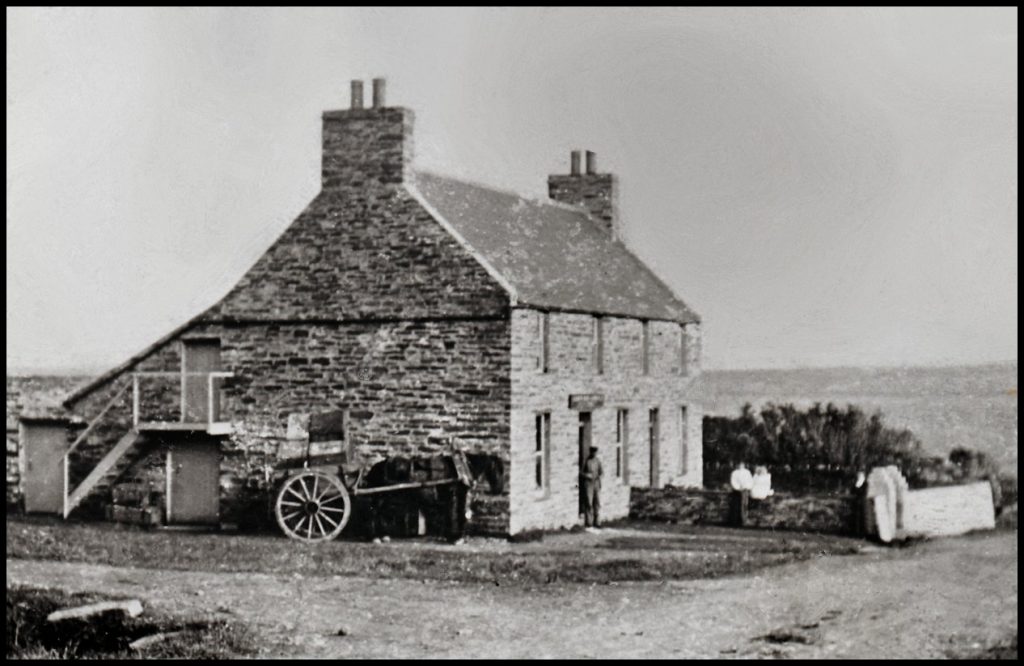
garden dyke of the cottage and the horse and cart are ready for the delivery round.
The door up the steps to the left leads to joiner Charlie Logie’s wood store.
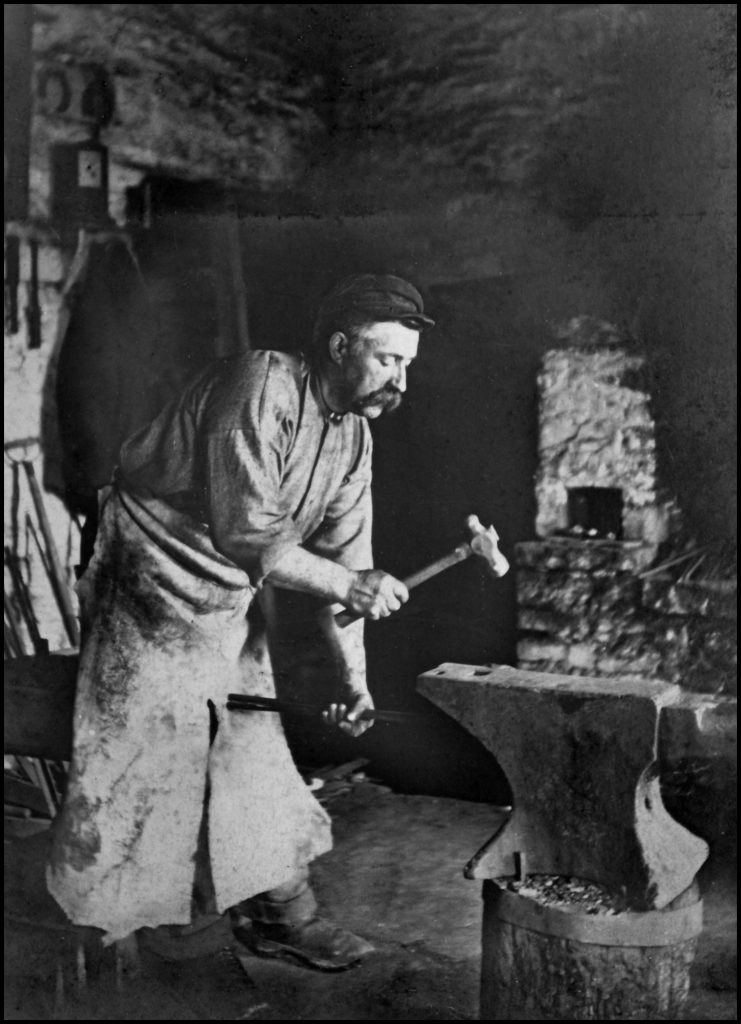
Rose Cottage and Harrold’s Shop, the two-storey building between Pier Cottage and the smiddy and joiner’s workshop, was first mentioned in the census of 1901, with John Mainland Harrold’s shop occupying the left ground floor rooms. Jock was the son of postmaster Hugh Harrold, Rendall, and Margaret Mainland, Bu, Wyre, and he was born in March 1859. On September 29th 1898 he married 27-year-old Esther Longbottom, daughter of Timothy Longbottom, agent for the Prudential Insurance Company, and Anne Powell of Alva, Clackmannanshire, minister Alexander Irvine Pirie performing the ceremony at Rose Cottage. Jock and Esther had two children, Jeannie, born in 1900; and John, who was born in 1904.
In the early 1900s Esther’s younger sister Mary Ann also lived at Rose Cottage, 15-year-old Maggie Jane Corsie was employed as a domestic servant, Samuel Inkster was a 25-year-old van man, and 15-year-old Kenneth McLean was an apprentice merchant in the shop. John Ernest Broadbent was a lodger, and at that time he was a 28-year-old registered general medical practitioner.
Master blacksmith William Sutherland at work at the Trumland smiddy.
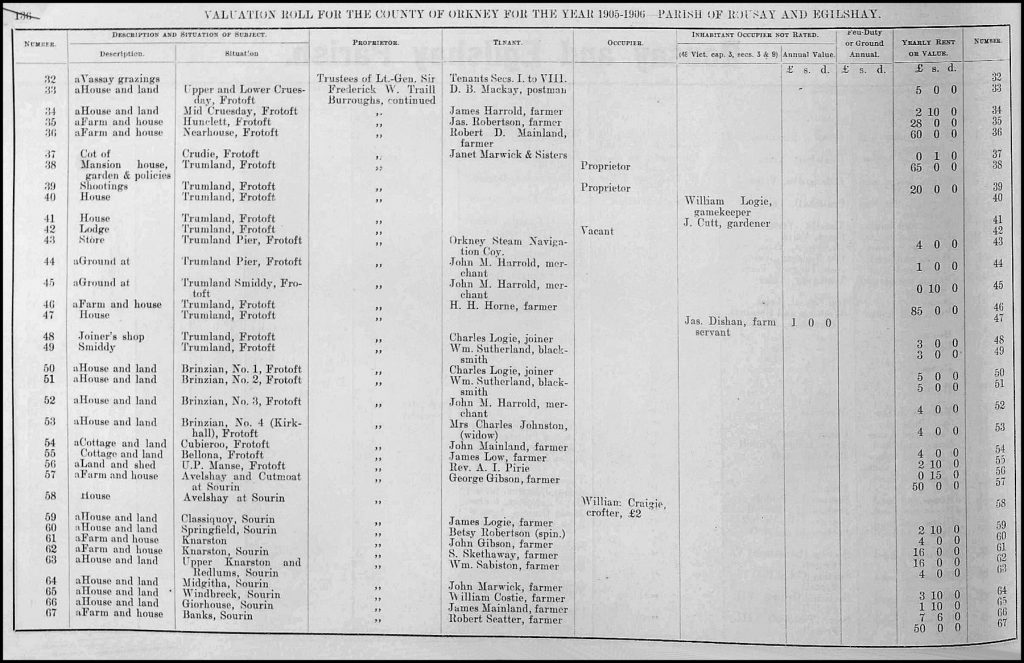
and where they lived in the Brinian – and the rent they paid for doing so.
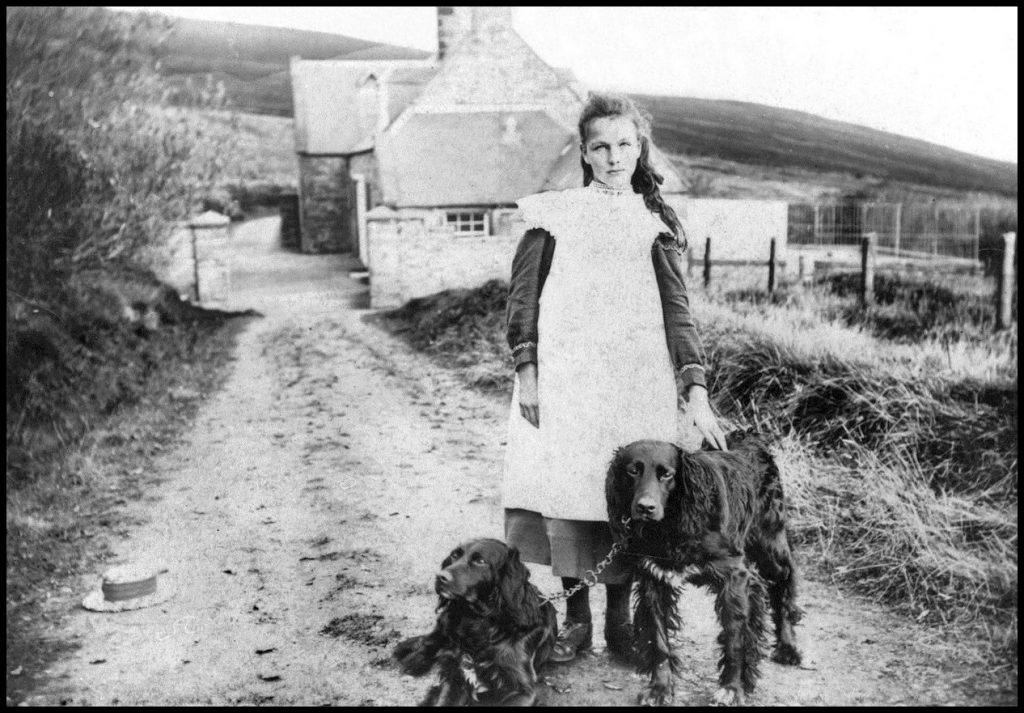
Meanwhile down at Pier Cottage John Logie, his wife Jane, and daughter Lizzie were still in residence, though John was working on the land and not at sea any more. He passed away in 1917 at the age of 91. His son, former Trumland estate gamekeeper William Logie moved into Pier Cottage from the accommodation above the stables at Trumland House. With him were his wife Helen Marwick, daughter Cecilia [known as Cilla] and her son James Marwick Craigie, the result of an illicit liaison with farmer James William Craigie. Young James was nicknamed ‘Steebly’ due to the location of his birth.
Rose Cottage was next to house a new occupant – and he was John Logie, Frederick William Traill-Burroughs’ butler at Trumland House. He was the oldest of the three Logie brothers, being born in 1856. William the gamekeeper was born in 1861, and Charles the joiner in 1869. John was the son of the laird’s yachtsmaster John Logie and his first wife Cecilia Gibson, Vacquoy, and he married Anne Marwick Craigie, daughter of John Craigie, Hullion, and Sarah Sinclair, Tratland, who was born in March 1855. The marriage took place at Hullion on January 26th 1882. Alexander Allardice of the United Presbyterian Church was the officiating minister and the laird, General Frederick William Traill-Burroughs and his wife Lizzie, were witnesses to the occasion.
John Logie’s tasks as butler were numerous. He would wait on the table at mealtimes, look after the silver in the house, do the rounds and lock up at night, care for the wine cellar, clean the knives and the shoes, answer to visitors who called, clean the furniture, and wind the clocks. On a more personal note John would look after his master’s clothes, take letters to and from his master and mistress, and in the latter years of the laird’s life he and his wife Ann would travel with and care for the Burroughs’ at their London residence.
Lizzie Burroughs, the laird’s wife, was a competent artist, a trait inherited from her D’Oyly grandparents. A number of her watercolours of the Rousay landscape used to hang in Trumland House, and she gave lessons and encouragement to any young servant who showed signs of artistic ability. John Logie was a superb artist in his own right, and an accomplished photographer too. Many of his paintings are still in existence today, and I have used a number of his photographs on the pages of this website.
Examples of John Logie’s artwork – Trumland Farm, Wyre and Gairsay [above left]; Westness House and Farm on the right [image courtesy of Ron Spence, Banchory]. Below are views of the Earl’s and Bishop’s Palaces and St Magnus Cathedral, Kirkwall – and Langstane, Frotoft. Images of the paintings are courtesy of Graham Lyon, Sandwick. Graham writes:- “The one of Langstane was a wedding gift to my great grandparents Betsy and John Mainland, dated the year they married [1896]. That of the Cathedral was a wedding gift to my grandparents Robert and Edda Mainland dated on the day of their wedding [1929].”
After the death of Frederick William Traill-Burroughs in 1905, and his wife Lizzie in 1908, John continued in his role as estate steward and caretaker to the executors of the Trumland estate. It was in this capacity he wrote a letter of reference for Thomas Marwick, who was forced to move south due to the state of his wife Emily’s health. The letter, written on Rose Cottage embossed notepaper, reads as follows:-
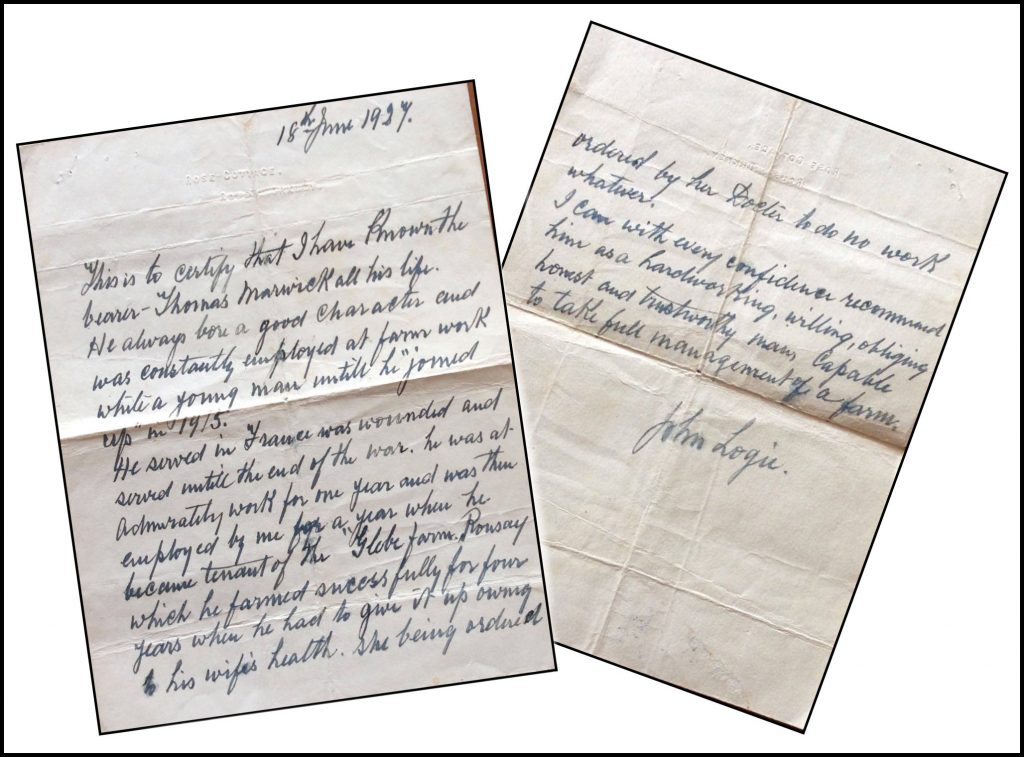
18th June 1927.
This is to certify that I have known the bearer – Thomas Marwick all his life. He always bore a good character and was constantly employed at farm work while a young man until he “joined up” in 1915.
He served in France, was wounded and served until the end of the war. He was at Admiralty work for one year and was then employed by me for a year when he became tenant of the Glebe farm, Rousay, which he farmed successfully for four years when he had to give it up owing to his wife’s health. She being ordered by her doctor to do no work whatever.
I can with every confidence recommend him as a hardworking, willing, obliging, honest and trustworthy man, capable to take full management of a farm.
John Logie.
I have already mentioned Maggie Simpson Sutherland [Peggy], daughter of William Sutherland, master blacksmith at Rousay pier. On November 22nd 1922 she married George William Marwick, known to everyone as Willie. He was the son of William Marwick, Corse, and Annie Taylor. William was a gardener at Westness House when in the ownership of Thomas Middlemore, who left Rousay in 1898 for Melsetter in Hoy. There William was employed as the estate steward, and it was that address that was used on 25-year-old Willie Marwick’s marriage certificate. His profession was that of a shepherd, and his bride Peggy was a 22-year-old cook. The proceedings were witnessed by Peggy’s brother George and Willie’s sister Edith, and the Rev David Simpson Brown of the United Free Church was the officiating minister.
In his book In Dreams We Moor, Robert Craigie Marwick tells us that in his childhood the shop at the pier [pictured below], located between the smiddy and what is now Brinola, belonged to Willie Marwick. He had a horse-drawn van which he took round the island once a week. Willie always seemed to want to move faster than the horse’s measured pace, giving the impression that he was dragging the animal along rather than leading it.
Shortly after the war Willie bought a car so that he could run a taxi service. One day a farmer who had shipped some cattle hired Willie to drive him home from the pier. A few days earlier Willie had had the misfortune to capsize his boat while out sailing. This gave the farmer an irresistible opportunity to have a little fun at Willie’s expense and as he climbed into the car he said to Willie that he hoped he was better at driving a car than he was at sailing a boat. These were the last words he was to utter until he had been set down at his farm on the other side of the island after the most hair-raising car journey he had ever endured. Never again, he vowed to himself, never again. Willie had scared the wits out of him with a display of devil-may-care driving at a breakneck speed that had broken every rule in the Highway Code. As his passenger staggered from the car Willie smiled to himself and drove off at his usual sedate pace.
Robert continues:- Standing cheek by jowl with Willie Marwick’s grocery shop were Charlie Logie’s joiner shop and the adjoining smithy of William Sutherland. The joiner and the blacksmith were great friends but this did not stand in the way of either one having some fun at the other’s expense whenever the opportunity arose. One day Charlie happened to look out of his window and spotted the minister, with a determined look on his face, heading in his direction. Charlie suddenly remembered that, six weeks earlier, he had promised the minister that he would attend right away to the repair of some broken windows at the manse. He had no excuses to offer the minister so he slipped out the back way and into the smithy next door. He quickly explained his predicament to his friend and asked if there was anywhere lie could hide till the coast was clear. The blacksmith suggested that Charlie could climb into the rafters where the minister was unlikely to spot him in the poor light. Charlie followed the suggested course of action and was crouched on a rafter like a hen on its perch when the minister entered the smithy. ‘I’m looking for Mr Logie’, he announced, ‘but he’s not in his workshop. Do you happen to know where I might find him?’ `Oh, yes’, replied the blacksmith cheerily, ‘he’s sitting up there in the rafters.’
A final mention of Willie Marwick comes from the wit and genius of Geordie Corrigall – the Bard of Ballarat. Here is a verse from one of his compositions entitled ‘Rousay Millionaires’.
And yi a’ ken Willie Marwick, he’s a most terrific wag,
His shop’s doon at Brinian whar the steamer dumps hids slag,
He’s aye prepared tae tak ye roond the island in his ker,
And his yarns’ll had yi laughan till yir very sides are sair.
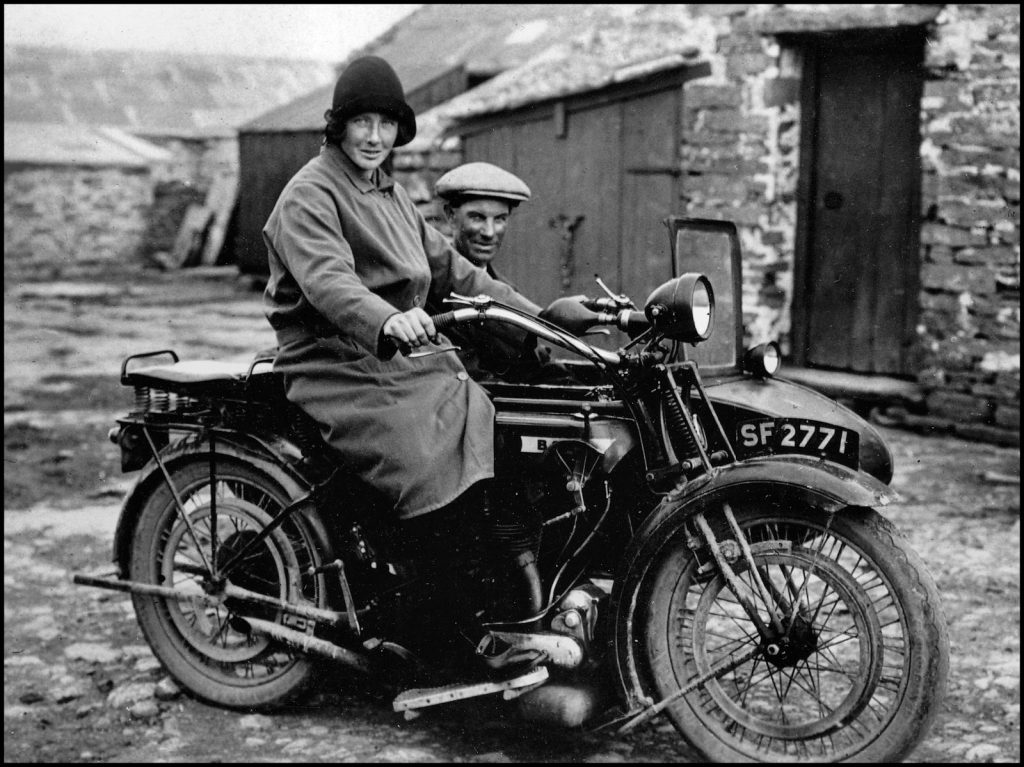
A house named Rognvaldsay was built in the mid-1930s, on the left just up from the pier storehouse. It was first occupied by James Thomas Reid Marwick and his wife Edith Gibson. James was the son of Mary Mainland Marwick, Midgar [no father on record] and he was born in December 1888. He married Edith, daughter of George Gibson and Annabella Logie of Avalshay, who was born in 1902. Edie was one of the first women in Rousay to own a motorcycle. Here she is on her 500cc BSA S26, with James in the sidecar. They were later occupants of Rognvaldsay.
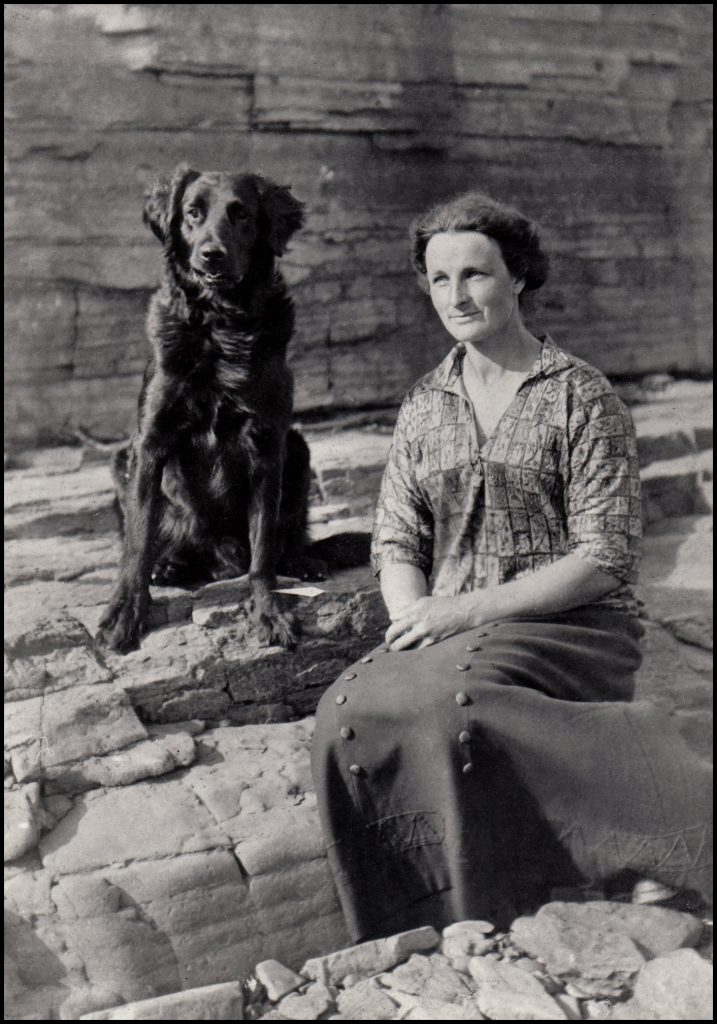
I never met Cilla Logie [pictured to the right on the shore with her dog c.1930] – but I encountered her son when I first came to Rousay in 1975. James Marwick Craigie was born above the Trumland House stables at noon on August 29th 1908, resulting in his nickname ‘Steebly’. He earned his living at the fishing, and later as a gardener at Trumland House. In 1958 James married Margaret Gibson Corsie (Peggy) of the Glebe, daughter of William Simpson Corsie and Lydia Gibson Baikie. Unfortunately Peggy was just 33 years of age when she died in 1964. James married again in 1975; his bride was Williamina McKenzie Flaws, daughter of Magnus and Williamina Flaws of Wyre, who was born in 1911. They ran a shop alongside Pier Cottage, and that is where I met and took the photo of them both in 1975.
Cilla passed away in 1983, James and Mina both died in 1988
Moving away from the pier, along the road beyond Ivy Cottage and Viera View, we come to Brinian Cot No. 3, later called Daisy Cottage. Its first occupant was Charlie Johnston, a ploughman at Trumland Farm, and in 1886/87 he was paying annual rent of £5.0.0. Charlie was married to Ann Harrold, and they and their six children later moved to nearby Cott.
Later tenants were John and Mary Cutt. They moved from the accommodation above the stables at Trumland House, where Orphir-born John was employed as a domestic gardener. His wife was Mary Craigie, daughter of shoemaker William Craigie of Lero, and Martha Mainland, Avalshay, who was born in August 1862.
Cott, or Cott Mowat as it was originally known, stood near the shore on what is now part of the land of Avalshay, a short distance west of the UP manse [now Brinian House] and the Established and United Presbyterian churches, and below Kirkha’. The old rentals reveal the earliest occupants as being James Linard in 1737, William Gairstie in 1769, and James Gairstie in 1771. In the early 1800’s it was where farmer Alexander Mainland and his family lived. He was married to Mary Cooper, the daughter of William Cooper and Cecilia Corsie, who was born in 1793. They had five children, William, Mary, Janet, Ann, and Betsy Scott, born between 1823 and 1831.
Alexander died in 1856 at the age of 86, and Mary died at Faro in 1877 when she was 84 years of age.
In 1861, Cott, by which name it was then known, was occupied by 31-year-old fisherman Archibald Yorston and his family. He was the son of John Yorston and Mary Barnet and he was born at South Tofts, Egilsay. He married Ann Craigie and they had three children, David, Jemima, and Margaret.
Cott was unoccupied in 1871, but ten years later William Marwick was farming four acres of land there. He was the son of Robert Marwick and Bell Mainland and was born on February 22nd 1847. On May 30th 1871 he married Sarah Leonard, daughter of James Leonard and Cecilia Inkster of Quoygray, who was born on October 20th 1847. They had six children; Bella, John, Betsy Ann, Williamina, Maggie, and Sarah, born between 1872 and 1882.
In 1891, 46-year-old farm servant Charles Johnston and his family lived at Cott. He was the son of John Johnston and Betsy Reid of the Brinian, born on July 24th 1844. In 1870, when he was living at nearby Kirkha’ he married Ann Harrold, the daughter of James Harrold and Bella Gibson of Boray, Gairsay, who was born on September 26th 1848, and they raised a family of four children: Margaret, born in 1871; Isabella Harrold, in 1873; John, born in 1877; Jemima, in 1879.
Kirkha’ was a croft close to the Established and United Presbyterian churches and the U.P. manse, now known as Brinian House. When the census was carried out in 1841, 75-year-old farmer William Reid from Stanecrew, Egilsay, lived there with his wife and family.
Originally he was married to Barbara Alexander, and they had a son, Archibald, who was born on August 21st 1805. William then married Christian Mowat and they had three children; Mary, born on May 9th 1810; Janet, on July 23rd 1812; and William, who was born at Pow, Sourin, on January 17th 1816.
By 1851 William had died, and his widow Christie, then a 74-year-old pauper, lived at Little Kirkha’. Agricultural labourer James Robertson and his family lived next door at Kirkha’ itself. James was the son of Alexander Robertson and Margaret Irvine, and he was born on April 6th 1818 on the island of Egilsay. At this time he and his wife Mary had two children; James, born in 1845, and Mary in 1847.
Widow Christy Mowat was still alive and living at Little Kirkha’ at the start of the 1860’s, but 49-year-old fisherman John Johnston had taken over the tenancy of Kirkha’. He was the son of Charles Johnston and Janet Harrold, and he married Elizabeth Reid, the daughter of George Reid and Barbara Logie of Pow, Westside, who was born in 1815. Between 1842 and 1857 they raised a family of nine children – six boys and three girls.
By 1871 Christy Mowat had passed away, and John and Elizabeth Johnston had been joined at Kirkha’ by their son Charles and his family. He was born on July 24th 1844, and like his father earned a living as a fisherman. In 1870 he married Ann Harrold, daughter of James Harrold and Bella Gibson of Boray, Gairsay, who was born in September 1848. At this time they had a three-month-old daughter, Maggie Ann, but they went on to have a family of four children.
Within ten years Charles was employed as a farm servant, and he and his family were living at Trumland. His father John still lived at Kirkha’, but was now farming four acres of ground there. Later, by 1891, when Charles was 46 years of age, he and his family had moved into Cott, close to Kirkha’, where his parents, John and Betsy still lived with their unmarried 39-year-old daughter Jane.
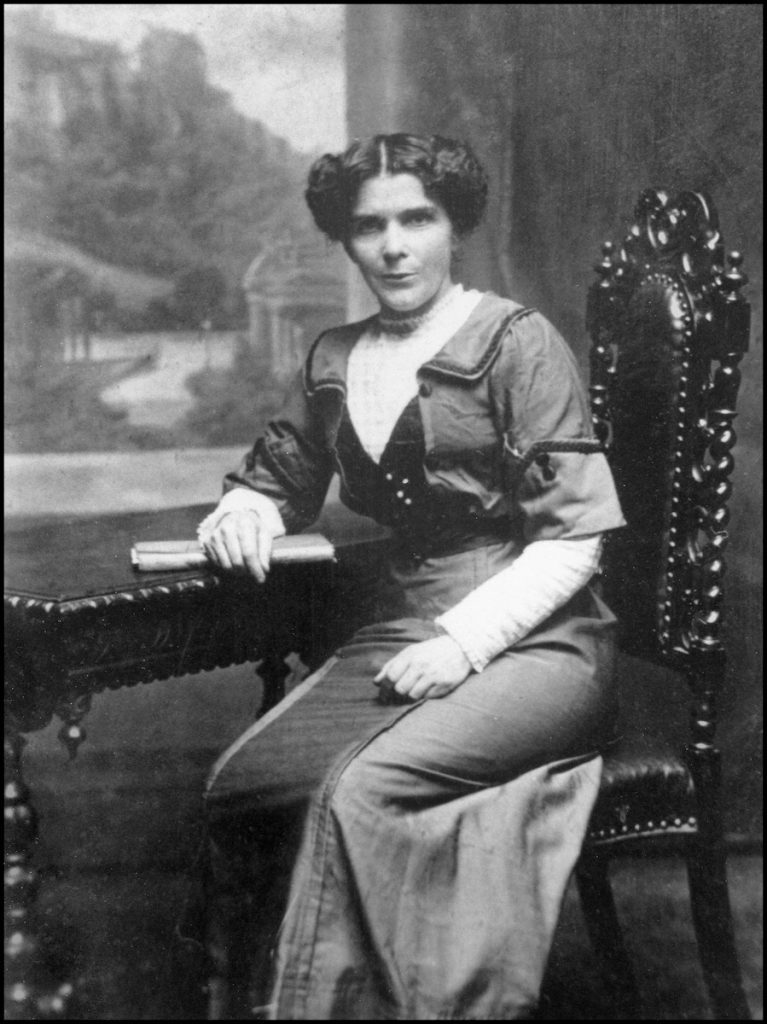
Later occupants of Kirkha’ were Sammy Inkster and his wife Maggie. Samuel Craigie Inkster was the son of James Inkster, Gorn later Scar, and Jane Inkster, Innister, and he was born in 1876. He married Jemima Johnston, daughter of Charles Johnston and Ann Harrold, but she passed away in 1924. On March 5th 1926 he married Maggie Jessie Louttit, pictured to the right] a 48-year-old cook from Maybank, Wasbister, the daughter of shoemaker William Louttit, Maybank, and Margaret Gibson, Broland. Maggie Jessie was born in 1877, and passed away at Kirkha’ in 1947. Sammy, seen below on various modes of transport, passed away in 1953.
The United Presbyterian Church and manse, pictured below, were situated east of Kirkha’. In the mid-1800’s the house was occupied by 45-year-old minister John McLellan, from Newton Stewart, Dumfries & Galloway, his 34-year-old wife Jane from Barrhead, East Renfrewshire and their three children Jemima, John, and William. The census of 1861 reveals 19-year-old Elizabeth Reid was employed as a domestic servant, and a border occupied one of the rooms at the manse – William H. Hankay, an unmarried 32-year-old gentleman from England.
In 1881 Alexander Allardice, a 36-year-old minister from Montrose, lived at the Manse, but by 1891 a new minister was in residence – 45-year-old Alexander Irvine Pirie from Drumoak, Aberdeenshire. He was married to 39-year-old Elsie Jamieson from Newburgh, Aberdeenshire, and they had three sons, Alexander Irvine, Alfred James, and John William. Come the time of the 1901 census being carried out Elsie’s 83-year-old widowed mother Margaret Jamieson was living with the Pirie family; Mary Mainland Marwick was their 42-year-old domestic servant, and George McLeod Lindores was a visiting piano tuner from Edinburgh.
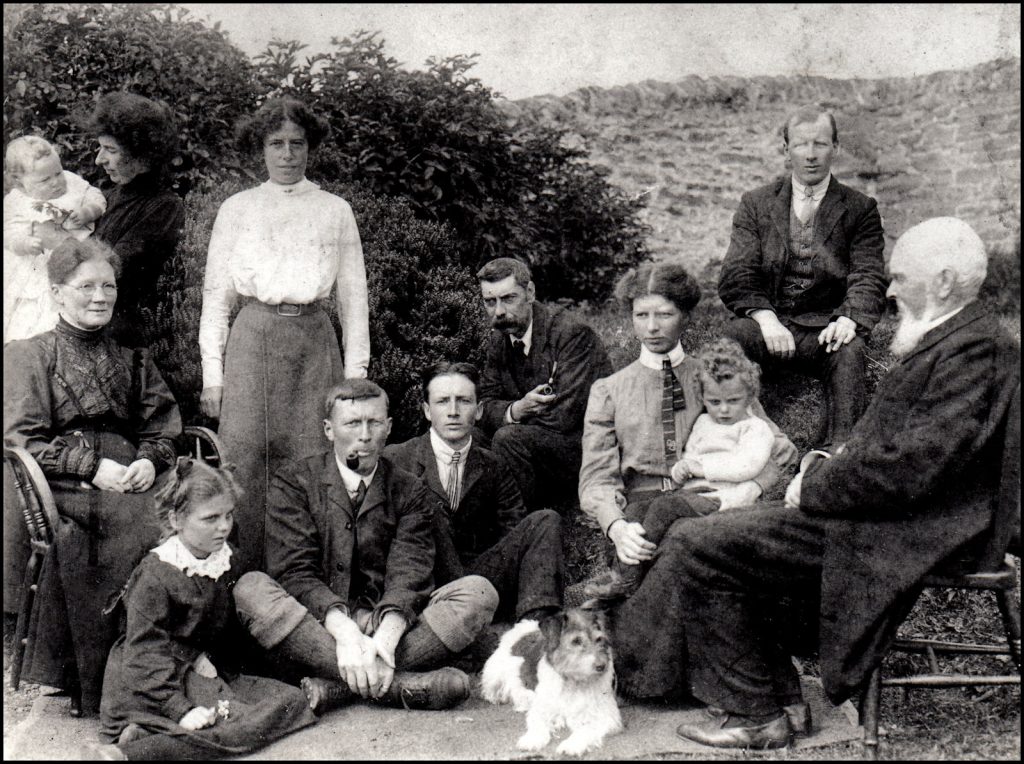
There are no names attached to the photo, so whether the folk are family members or parishioners I do not know.
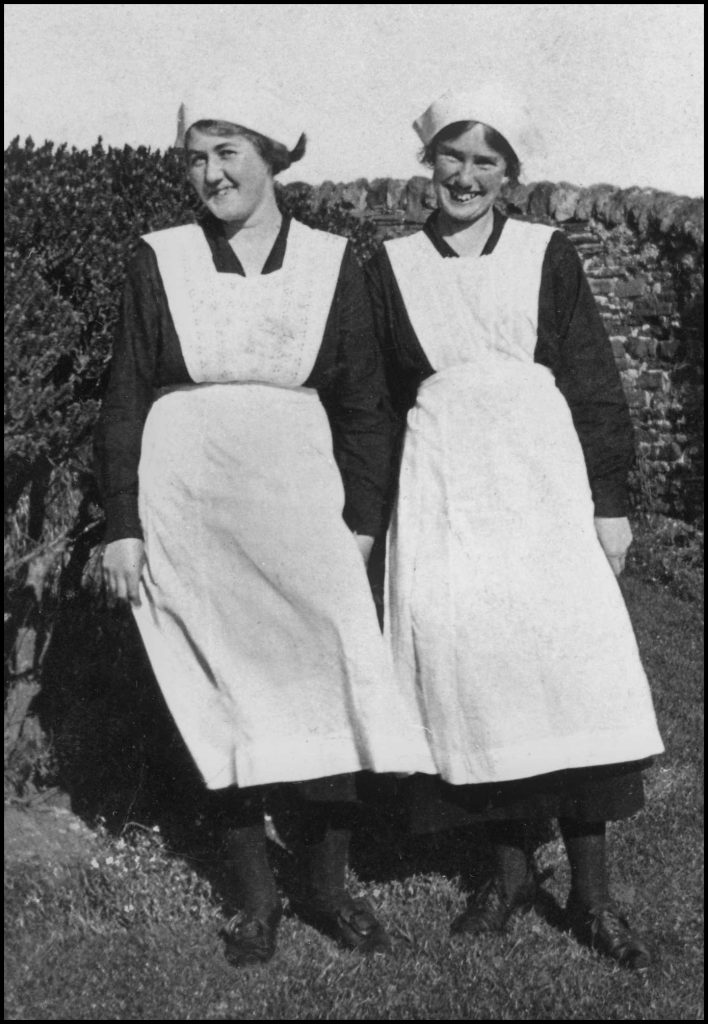
as housemaids at Brinian House, the former U.P. Church
manse, in the 1920s.
[All photographs are, unless otherwise stated, courtesy of the Tommy Gibson Collection.]
